Enquire Now
- Hidden Tour Title Hidden
- Hidden Tour Length Hidden
- Hidden Tour URL Hidden
- Hidden Tour Price Hidden
- Hidden Tour Style Hidden
- Hidden Compared Tours Hidden URLs
- Your name * First Last
- Your email address *
- Hidden Alternative Email (deprecated)
- The tour you're intested in
- The tours you're interested in Please do not edit these tour names so we can assist you with your choices.
Please enter your number below.
- When would you like to travel? Jun 2024 July 2024 Aug 2024 Sep 2024 Oct 2024 Nov 2024 Dec 2024 Jan 2025 Feb 2025 Mar 2025 Apr 2025 May 2025 May 2025 Jun 2025 Jul 2025 Aug 2025 Sep 2025 Oct 2025 Nov 2025 Dec 2025
- 26 - 40 Days
- 15 - 25 Days
- 8 - 14 Days
- How many travelers? * Select... 1 2 3 4 5 6 7 8 9 10
- 12 - 17 years
- 18 - 39 years
- 0 - 11 years
- 0 - 7 years
- 8 - 9 years
- 10 - 11 years
- South Africa
- What travel style in Africa would you prefer? * Not Sure Accommodated Tour Camping Adventure Small Group Safari
- Your question or query Feel free to ask us anything! We can advise on breathtaking scenery, colourful cultures, local cuisine and of course, amazing wildlife!
- By submitting your enquiry you agree to our terms of service .
- Phone This field is for validation purposes and should be left unchanged.

Check Availability
Answer these quick questions and we'll confirm availability!
- Hidden Tour Title
- Hidden Tour length Hidden
- Your selected dates * Choose your travel dates I'm not sure yet
- Please indicate your preferred travel month. * Select month... June 2024 July 2024 Aug 2024 Sept 2024 Oct 2024 Nov 2024 Dec 2024 Jan 2025 Feb 2025 Mar 2025 Apr 2025 May 2025 Jun 2025 Jul 2025 Aug 2025 Sep 2025 Oct 2025 Nov 2025 Dec 2025
- Hidden Ages of travelers?
- Hidden If it is available, would you like to reserve a place? Yes I like this tour but would love to see more options Yes, please send payment details
- You will be redirected to a thank you page upon successful form submission. Please do not click away.
- Email This field is for validation purposes and should be left unchanged.
Home / Tours / Wild Dog Safaris

NEED HELP PICKING A TOUR?

- First-hand experience
- Advice and guidance
- We're passionate travelers
Filter by Duration
Filter by style, filter by countries, filter by starting point, wild dog safaris.
Wild Dog Safaris in Namibia has been running adventure safaris since 1997 with the aim of running trips that allow you to relax and explore the beauty that is Namibia. Your days will be spent in the sun, dunes and wildlife of this great country that is Namibia.
BEST WILD DOG SAFARI TOURS:
Wild Dog Safaris Accommodated Tours
Wild Dog Safaris Camping Tours
15 – 25 Day Tours
8 – 14 Day Tours
1 – 7 Day Tours
Filter by Length
Currency conversion estimated. Base currency is South African Rand (ZAR)
Showing the single result
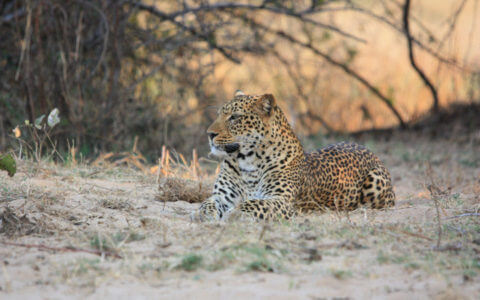
R 45,450
Livingstone to Zanzibar Overland Tour (Camping)
More categories.
- Further Info
Wild Dog Safaris Zimbabwe (1)
What does a Wild Dog safari include or exclude?
Safaris include:
All transport Three meals a day (unless differently specified) Tea & coffee in camp All camping equipment Park entrance fees Camping OR accommodation fees Professional guide Camp Assistant (unless differently specified) Pick up & drop off from accommodation in Windhoek
Safaris exclude:
Sleeping bag (can be hired) Alcoholic beverages Soft drinks & bottled water Personal travel insurance
- You are here:
- Tour Operators
Wild Dog Safaris

The Wild Dog Safaris team
- Company Profile
- Destinations
Wild Dog Safaris has been in operation since 1997 and specializes in camping and accommodated safaris at inexpensive prices. We operate our own trips with experienced full time safari guides throughout Namibia, Okavango Delta and Victoria Falls. We have safaris leaving weekly throughout the year, with fixed departure dates and have a minimum of 2 clients for the trip to depart. We also offer self-drive trips and private guided trips on request.
Safaris & Tours 0 – Offered by Wild Dog Safaris
No safaris offered by Wild Dog Safaris on SafariBookings at the moment.
Reviews 64 – About Wild Dog Safaris
Latest user review.

Great company with wonderful staff
The team at Wild Dog Safaris organized a self-drive trip for us. Everything was arranged perfectly and the 4x4 vehicle was in excellent condition. It was one of the best Africa trips I made. Namibia is such a beautiful country. I would...
Full Review
- All corporate and/or tour info is provided by Wild Dog Safaris, not SafariBookings
- The tours offered by Wild Dog Safaris are subject to their terms & conditions
- Israel & Palestine
- United States
Wild Dog Safaris Namibia: Tour Review
Epic desert sunsets. Remote landscapes. Lions, elephants, rhinos, and leopards. I saw all these things and more during my two weeks in Namibia . And it was all thanks to Wild Dog Safaris.
Now, I’m not normally a tour person. I’m a firm believer in public transportation, bumps, dust, crowds and all. I like to choose my own activities and travel on my own timeline.
But as soon as I started planning my trip to Namibia, it became obvious that I had to take a tour. Namibia is one of the least-densely populated countries in the world. And where there are no people, there are no buses. While you can get between a couple of the major population centers by public transport, if you want to see the dunes and wildlife the country is so famous for, you need your own wheels. And as someone who hasn’t driven since she was 19, the idea of renting a car and driving it out into super-remote desert country — alone — on gravel/dirt roads — seemed a bit much.
So I started researching the various tour options. I could do an overland trip with a company like G Adventures or Acacia Africa. But they only offered Namibia as part of a multi-country tour — and they rushed through it in only a week. I had to keep my budget down, so I needed a company that would run camping tours. And I desperately wanted to see both Fish River Canyon and Kolmanskop Ghost Town .
Only one company met my requirements: Wild Dog Safaris. After some minor back-and-forth with their staff, I booked the trip. I ended up traveling with the Wild Dog Safaris team for two weeks, in a group of six women ranging from their early 20’s to their early 60’s. In this post, I’ll review my experience with them.
I’m writing this post because it was very difficult to find information about tour companies in Namibia online before I went, and I want to help people like you decide which safari is right for you. I paid my own way on this trip, 100%, just like you would — I have no relationship with the company and this blog was not even live when I was in Namibia. All opinions are my own.
Before the tour: Communication and booking: 8/10

The booking process with Wild Dog Safaris was straightforward. I reviewed the itinerary options on their website and decided on a two-week camping safari, Windhoek to Windhoek, covering both the northern and southern parts of the country. I checked which days of the week the trip I wanted leaves, verified that I could find flights that would make sense, and sent an email inquiry.
Memory from the front office team at Wild Dog Safaris got back to me right away. She sent more detailed information about the itinerary, a list of recommended hotels in Windhoek that they could help me book if I wanted to arrive before my tour, detailed terms and conditions, and information on the payment. I had a couple additional questions at that point and Memory always responded within a day.
When it came time to make the payment, I was able to do it online and without paying fees. I simply used an e-check service. It never felt insecure. The payment did take awhile to process (like, weeks), which was partially because I sent it over the Christmas holidays. I had to follow up with Memory a couple times to ensure they received it, but it got through eventually.
The front office team was super-helpful throughout the entire process, and had good and thorough answers to my questions. I felt completely confident in their level of organization and knowledge about travel in Namibia.
On safari with Wild Dog Safaris Namibia
The day I set off on my safari, the Wild Dog team picked me up at exactly the time they’d promised. They brought everyone leaving for various trips to their office, where we met our safari-mates, put our luggage in the correct vehicles, and were shown a map detailing our route. Then we were off!
The guides and assistants: 10/10

Wild Dog Safaris’s guides double as drivers. Both my guides were excellent drivers — no crazy speeding here. But on top of that, they really know their stuff when it comes to the landscapes, people and wildlife of Namibia.
My guide for the first week of the trip was Gabriel. He’s young, soft-spoken, and very insightful about Namibian culture. He did a brilliant job of keeping our group on schedule, while giving us the flexibility to see things at our own pace. He also went way above and beyond when he got our group to the base of Dune 45 ahead of all the others.
The second week, Raymond took over as my guide. He is Gabriel’s polar opposite: super-outgoing, a little older, gregarious, and very passionate about wildlife. It was great to have him as our guide in Etosha National Park — whenever we were feeling tired of game driving, he’d say “I came here to see animals, didn’t you? Let’s go!” He knew where to find elephants in rainy season and could describe the behavior of wildebeests in-depth.
The guides were accompanied by assistants who helped with camp chores and cooked. The first week, our assistant Manfred also hung out with the group. The second week, our assistant was quieter and didn’t spend much time with us.
Overall, I was very happy with the guides at Wild Dog Safaris. I never asked a question they didn’t have the answer to. I felt 100% safe in their company. And they added to the fun of the trip — by the time we parted ways, they felt like family.
The camping experience: 9/10

Wild Dog Safaris offers both camping and lodge safaris. As a budget traveler, I opted for the camping experience. They keep their camping and lodge safaris separate, so you don’t need to wait for lodge-goers to finish breakfast or anything.
Wild Dog provided all the gear for camping. That included one three-person tent for every two people, comfy sleeping mats, and sleeping bags. The tents were high-quality and durable, and they held up (reasonably) well to rain and dust. Mosquitoes were only a problem one night out of the ten nights in the bush.
The guests were expected to “help” set up our own tents. In practice, this meant we went through some of the motions of trying, but the guides quickly became exasperated and just did it for us.
We traveled with a full set of cooking equipment, plates/knives/forks/etc., dish soap and wash bins, several battery-operated lights, camp chairs, and a hand-washing basin. While we were responsible for washing our own dishes, it certainly never felt like we were roughing it.
Most of the campsites we stayed at were absolutely amazing — far better than most U.S. campsites I’ve stayed in. They came complete with luxurious, hot-water showers, charge points for electronics, swimming pools, wildlife-watching spots, and even occasional Wi-Fi at the camp store!
We stayed at hotels in Lüderitz, Windhoek for a night between the northern and southern halves, and Swakopmund. All hotels were covered by the tour price. They were invariably clean and safe, and far better value for money than anything we could have booked on our own. The place in Swakop was a little dull and business-y, but they made a surprise birthday cake for one girl in our group so it’s hard to complain.
The activities: 10/10

Wild Dog Safaris definitely kept me busy during the two weeks in Namibia. I think the only time there was real downtime was during the afternoon after we hiked up Dune 45 for sunrise. There was lots of car time, and evenings were pretty chill, but this would not be a good trip for someone hoping to relax at the campsite for hours each day.
The activities were all really worthwhile, though. Even the ones I wasn’t sure I cared about — like visiting a mesosaurus fossil site or hiking to rock art galleries — turned out to be surprisingly cool. Opportunities to see wildlife abound.
The two-week tour takes in some off-the-beaten-path locations, like Damaraland, the desert near Aus, and the Kalahari Desert . So even though you are on a tour, it doesn’t feel like you’re just chasing the other tour buses. I visited in off-season, so even Etosha and the Namib Desert were virtually empty, and the off-the-beaten-path places felt way more remote than I’d been expecting.
My one complaint was we didn’t do an early-morning game drive in Etosha. It would’ve been nice to leave the camp at 5 am one morning for an hour or two, and then go back and have breakfast. We never left the camp before 8 am. In dry season, when wildlife shows up at the campground water holes, this may not be as relevant.
The food: 8/10
Most of our meals were prepared at the campsite or on the road by the Wild Dog Safaris team. I ate at restaurants (at my own expense) a few times.
Breakfast was a 50-50 split between hot breakfast and yogurt/cereal/pastries/toast. The best was after we climbed down from Dune 45 at sunrise, there was a hot breakfast waiting for us in the parking lot, in the shadow of the dune. It truly doesn’t get any better than that. We were served tea and (instant) coffee every morning before we even had to take down the tents.
Lunch was something like sandwiches, hot dogs or tuna salad that could easily and quickly be prepared at a roadside rest stop. Ingredients for a simple salad were always available, as was fresh fruit.
Dinner was the big meal of the day. The cooks really went all-out. Most meals had a main dish and several sides, including vegetables, but were pretty meat-dominant. Upon request, Manfred even cooked us a local meal of grilled eland (antelope) and ugali (a corn-based, doughy starch). The food was always tasty and plentiful. I picked up a bottle of Peri-Peri hot sauce, which made the grilled sausages and meats that much better.
Wild Dog Safaris caters to vegetarians if you let them know in advance. While I’m a vegetarian at home, I didn’t want to miss out on sampling the local food, so I ate meat the whole time. It only really started to bother me the last two days.
The vehicles: 8/10

I traveled in two different Wild Dog Safaris vehicles — the first week in an eight-seat Land Cruiser; the second week in a fifteen-seat truck.
Both vehicles were ready for bush driving. Even when the roads were bumpy, we didn’t really feel it. Neither was air-conditioned, but the dry heat of Namibia is pretty tolerable if you open the car windows. Both vehicles also had pop-up roofs for game viewing.
My preferred car was the Land Cruiser. We only had six people in our group so we had plenty of space. We carried all our gear in a trailer behind us. It was ideal for southern Namibia because we were able to drive the final 5 km into Dead Vlei, which is 4×4-only — saving us a 5 km walk in the mid-day desert sun. The one downside was we busted a spring on our trailer on the road away from Fish River Canyon. It was fixed with minimal disruption to the trip (more on that shortly).
The fifteen-seat truck was almost too much space for our six-person group. Every person got a row to themselves, which made it harder to bond with my car-mates. The pop-up roof also made a lot of noise, especially on bumpy roads. But on the plus side, the windows were much better for game viewing in Etosha.
Both cars were clearly well-maintained and in good condition. I never had any safety concerns.
Dealing with the unexpected: 10/10
Each week of my Namibia road trip with Wild Dog Safaris, one unexpected problem came up. I see these problems as the truest indicators for the quality of a tour company. Do they handle it professionally? How do they communicate with their guests about it? How do they make up for any missed opportunities?
Wild Dog amazed me with their handling of both problems.
Mechanical breakdowns and closed repair shops

The first week, trouble arose on the road out of Fish River Canyon. It was long, gravel, and very bumpy. Something must’ve felt wrong, because as soon as we got back to the tarmac, Gabriel pulled over and inspected the vehicle. It turned out a critical spring had broken on the trailer.
Luckily, while we had another 300+ km to drive that day, were were only a few kilometers away from Keetmanshoop. Keetmans is a larger town with several auto repair shops. So we headed there, only about ten minutes out of our way. Meanwhile, Gabriel was in contact with the Wild Dog Safaris front office and communicated exactly what we were going to do to the guests.
It was a Sunday, and in Namibia, Sundays mean everything is closed. So Gabriel dropped us off at a supermarket and shopping mall to grab lunch (which he would reimburse us for) while he found an open repair shop.
Not more than an hour later, Gabriel came to pick us up — without the trailer. It turned out no repair shops were open. So he left the trailer to be fixed the next day, piled all our suitcases into the back of the Land Cruiser, and we continued on our way. Meanwhile, the Wild Dog Safaris front office sent someone else to pick up the trailer. While we stayed in a (planned) hotel for one night in Lüderitz, the trailer was fixed, and it — along with our camping gear — were waiting for us when we arrived at our campsite the next day.
The total disruption to our trip was about 30 extra kilometers driven, one lunch in a supermarket parking lot, and maybe an hour of our time. Not bad at all.
Rainy season problems

The second unexpected disruption was more serious. We were driving out of Etosha National Park, toward our campground in Damaraland. All of a sudden, the skies opened up in an hour-and-a-half-long downpour.
When we got back on our way, we made it just to the edge of the tarmac road. But where the dirt road began, it had completely turned into a river. My heart sunk. If we couldn’t get across this road, we’d miss out on our entire Damaraland experience — or so I thought.
Raymond made some quick phone calls to the Wild Dog Safaris office and some other guides. He then explained to the group that even if we could get across this river, there were several more — and there was a real chance of getting stuck between them.
It was getting late, so Raymond proposed that we find somewhere to camp for the night. Then, the next day, we had a few options. Maybe we could cross the river and do the planned rock art gallery hike at Twyfelfontein. But if not, we could still probably get to a different rock art gallery at Brandberg.
Raymond somehow negotiated us a campsite at a nearby campground that was fully booked. He helped us organize a quick evening walk through the forest. Then we made dinner and hunkered down for a wet night.
In the morning, Raymond raced around to gather information about the roads from the locals. He determined pretty quickly that attempting to get to Twyfelfontein would be risky. So he recommended we try for Brandberg instead. He asked our group how we felt about that before committing to it, and we were all in.
In the end, we went to Brandberg, saw some amazing rock art, and missed out on nothing. Raymond stayed calm and consulted our group at each stage. It was all very professional and stress-free.
Overall experience with Wild Dog Safaris Namibia: 9/10

In sum, I could not be happier with my overall Wild Dog Safaris experience. The guides were great, the food was good, the campsites were amazing, and I got to do every single activity I’d wanted to — and then some.
There are tiny tweaks the company could make to improve. Things like properly sealing the pop-up roof while driving, providing more creative lunch options, and being a little more responsive when it comes to confirming payments from abroad. But those are really, extremely minor things in the context of the trip as a whole.
As I said in the beginning, I don’t have any sort of professional relationship with Wild Dog Safaris. I just had an awesome trip with them. I’m hoping this review can help other travelers like you decide whether a camping tour like mine is right for you when you visit Namibia.
Have any questions about my experience with Wild Dog Safaris? Feel free to leave a comment!
Like this post? Pin it!

Read more about Namibia here
Carrie is the founder of Trains, Planes and Tuk Tuks. For more than seven years, she's been solo-backpacking around the world to places few other tourists dare to explore -- from Ethiopia to Nicaragua to Jordan and beyond. When she's not on the road, you can find her hiking in the Blue Ridge Mountains and eating the world's best barbecue in her home city of Asheville, NC.
This site uses Akismet to reduce spam. Learn how your comment data is processed .
Thank you for sharing! I hope to visit safari one day so this has been more than helpful! 🙂

[…] a tour with a Namibian travel company. I’m not comfortable bush driving, so I did a tour with Wild Dog Safaris, which I highly recommend. Even if you travel in your own car, you may want to use a travel company […]
[…] with every other vehicle I traveled in in Uganda, and compared with my past experiences with vehicle breakdowns on safari, my safari car with Red Chilli was pretty […]
- Destinations
This website uses cookies to ensure you get the best experience on our website. Learn more
- Australian Dollars
- British Pounds
- Canadian Dollars
- New Zealand Dollars
- South African Rands
- Swiss Francs
- U.S. Dollars
Talk to an expert +44 203 405 6666 Lines open now
With such a variety of habitat there is a great range of wildlife in Namibia.
Namibia wildlife safaris
Top places for wildlife safaris in namibia, ruppell's korhaan fly-in safari.
9 days • 4 locations WINDHOEK AIRPORT TO WINDHOEK AIRPORT
US$10,300 - US$15,700 per person
Desert Rhino Camp
Desert Rhino Camp is one of the best places in Africa to see black rhino roaming free, and to track them on foot, so it's a great place for a wildlife safari in Namibia if your particular focus is on rhino.
Hoanib Skeleton Camp
Guided drives along the Hoanib riverbed and the floodplains beyond offer an intriguing prospect for a wildlife safari in Namibia. Visitors to Hoanib Camp have a pretty decent chance of spotting the area’s desert-adapted elephants, as well as Cape fur seals by the coast.
Rock Agama Self-drive Safari
9 days • 6 locations WINDHOEK AIRPORT TO WINDHOEK AIRPORT
US$6,070 - US$13,110 per person
Okonjima Bush Camp
Visitors at Okonjima can usually have the chance to view big cats at much closer quarters than is possible in most national parks. With most of the animals habituated to humans, this is a good place to end a wildlife safari in Namibia..
Mowani Mountain Camp
Mowani Mountain Camp offers guided nature drives into the dry river beds in this area. The game isn’t dense here, but you’ll probably see a good sprinkling of antelope and birds – and have a fairly good chance of spotting the area’s desert-adapted elephants.
Little Ongava
Within the Ongava Reserve, and with Etosha National Park on the doorstep, Ongava Tented Camp offers wonderful wildlife viewing including the opportunity to see black and white rhino, elephant, lion, cheetah, leopard and a plethora of plains game.
Brown Hyena Self-drive
14 days • 8 locations WINDHOEK AIRPORT TO WINDHOEK AIRPORT
US$7,980 - US$10,070 per person
Onguma Tented Camp
With its location on the private Onguma Reserve, and Etosha National Park on its doorstep, Onguma Tented Camp is a fantastic base from which to explore these wildlife-rich areas on any safari in Namibia.
Ongava Lodge
Ongava Lodge offers excellent game-viewing opportunities, both within the Ongava Reserve and the neighbouring Etosha National Park. Added bonuses include possibly tracking white rhino on foot and night drives in the reserve, neither of which is allowed in Etosha.
Flamingo Fly-in Safari
6 days • 3 locations WINDHOEK AIRPORT TO WINDHOEK AIRPORT
US$5,040 - US$6,880 per person
Pelican Fly & Drive Safari
10 days • 5 locations WINDHOEK AIRPORT TO WINDHOEK AIRPORT
US$5,870 - US$7,810 per person
Ongava Tented Camp
Within the Ongava Reserve, and with Etosha National Park on the doorstep, Ongava Tented Camp offers wonderful wildlife viewing including the opportunity to see black and white rhino, along with elephant, lion, cheetah, leopard and a plethora of plains game.
Chongololo Self-drive Safari
21 days • 11 locations WINDHOEK AIRPORT TO WINDHOEK AIRPORT
US$7,500 - US$10,090 per person
Mundulea Reserve
Mundulea’s wildlife diversity includes large herds of eland as well as roan, tsessebe, zebra, giraffe and black-faced impala, though its walking-only policy gives a new dimension to a Namibian safari. It's also a centre for research into Namibia's endemic subspecies.
Bateleur Fly-in Safari
7 days • 4 locations WINDHOEK AIRPORT TO WINDHOEK AIRPORT
US$5,930 - US$9,370 per person
Hoopoe Fly-in Safari
11 days • 4 locations WINDHOEK AIRPORT TO WINDHOEK AIRPORT
US$6,250 - US$9,370 per person
Namaqua Chameleon Self-drive
12 days • 7 locations WINDHOEK AIRPORT TO WINDHOEK AIRPORT
US$2,920 - US$4,670 per person
Okonjima Plains Camp
Visitors at Okonjima can usually view big cats at much closer quarters than is possible in most national parks. With most animals on the reserve habituated to humans, this is a good place to end a wildlife safari in Namibia.
The desert-adapted elephant, found only in the north-west of Namibia, can be spotted on game drives from Camp Kipwe, although sometimes the distances can be quite long.
Skeleton Coast Safari
5 days • 5 locations WINDHOEK AIRPORT TO WINDHOEK AIRPORT
US$8,440 - US$14,480 per person
Leylandsdrift Camp
The Hoarusib River valley, in which Leylandsdrift Camp is situated, is a great place to track desert-adapted elephant. The vegetation and natural springs in the area act as magnets for these wonderful animals, as well as other desert dwelling species.
Best camps & lodges for Wildlife safaris in Namibia
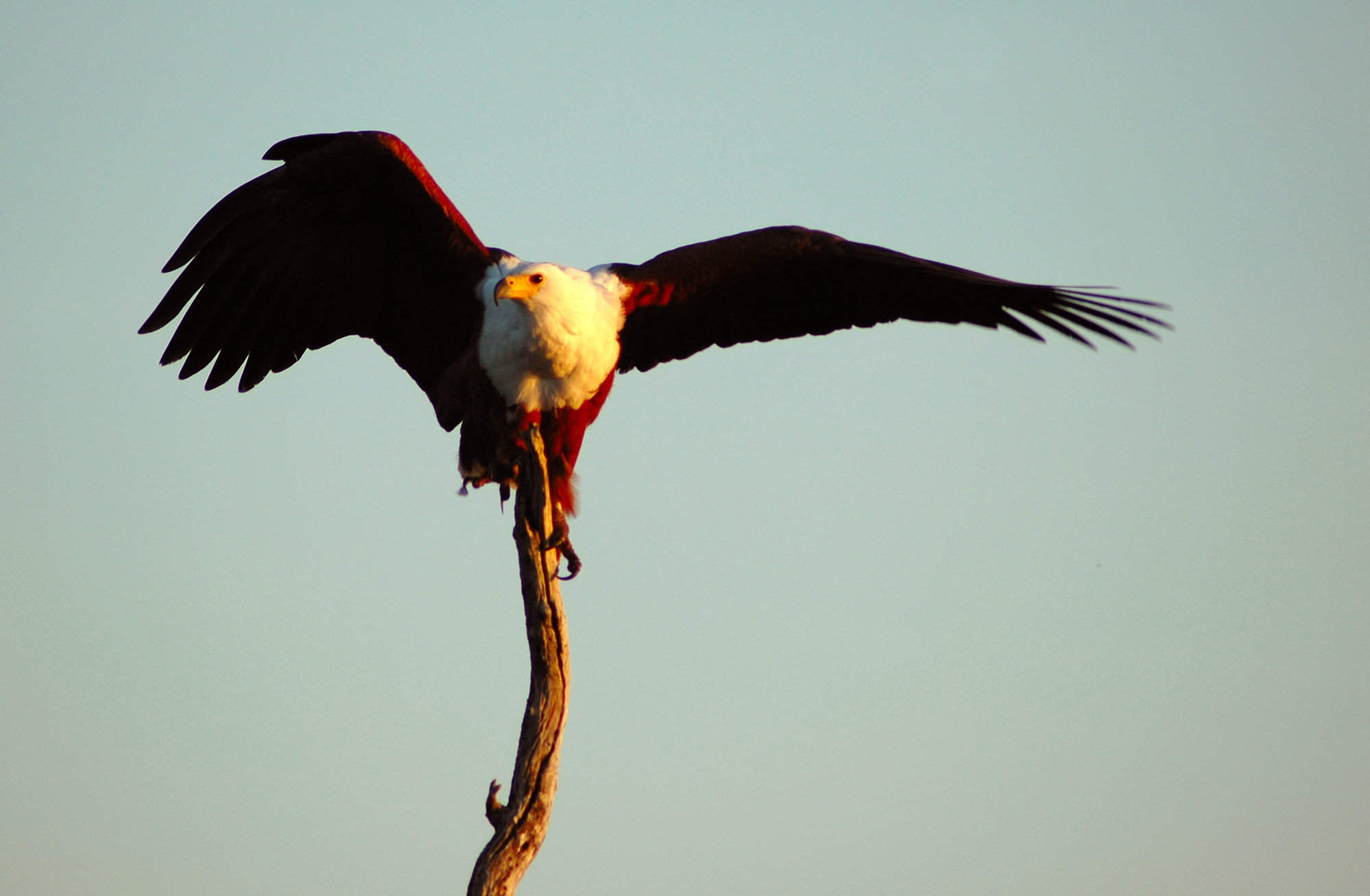

Cascade Island Lodge
Cascade's motor-boat trips along the Chobe and Zambezi rivers are excellent for birdlife, and spotting hippos and crocodiles. Relaxed big game from herds of elephants to massive congregations of buffalo are also often seen – especially during Botswana's dry season .

Palmwag Lodge
Palmwag is one of the last wilderness areas in the world outside of a national park. You can see a variety of game including, with a bit of luck, free-roaming black rhino, desert-adapted elephant and lion, all in the most spectacular landscape far off the normal tourist routes.
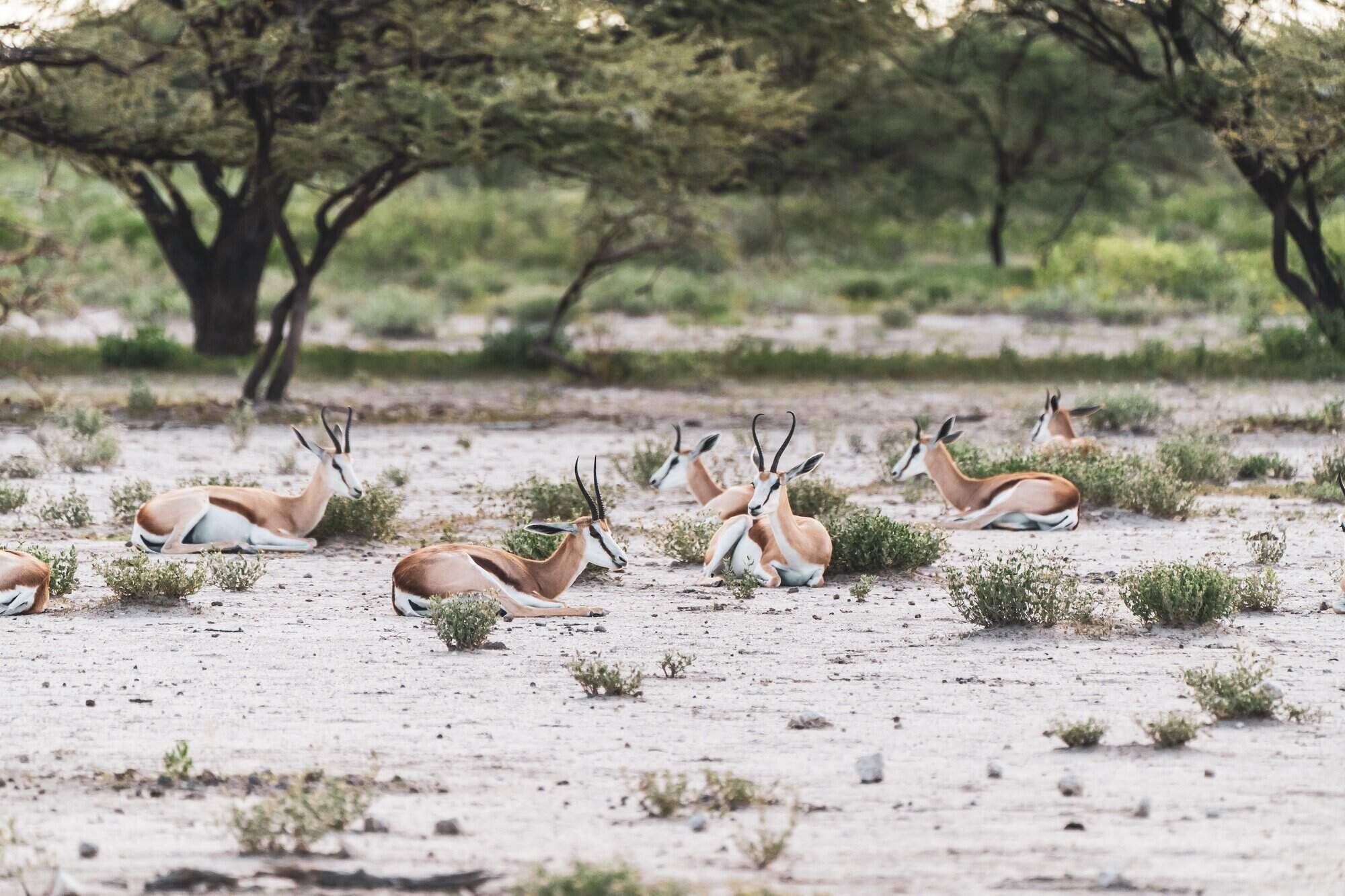
Namutoni Camp
Overlooks the flood-lit King Nehale waterhole, Namutoni gives visitors the opportunity to observe animals and birds at close range. The camp's main attracting are self-drive forays around the park. The Fisher's Pan nearby is often used as the breeding site for flamingoes.
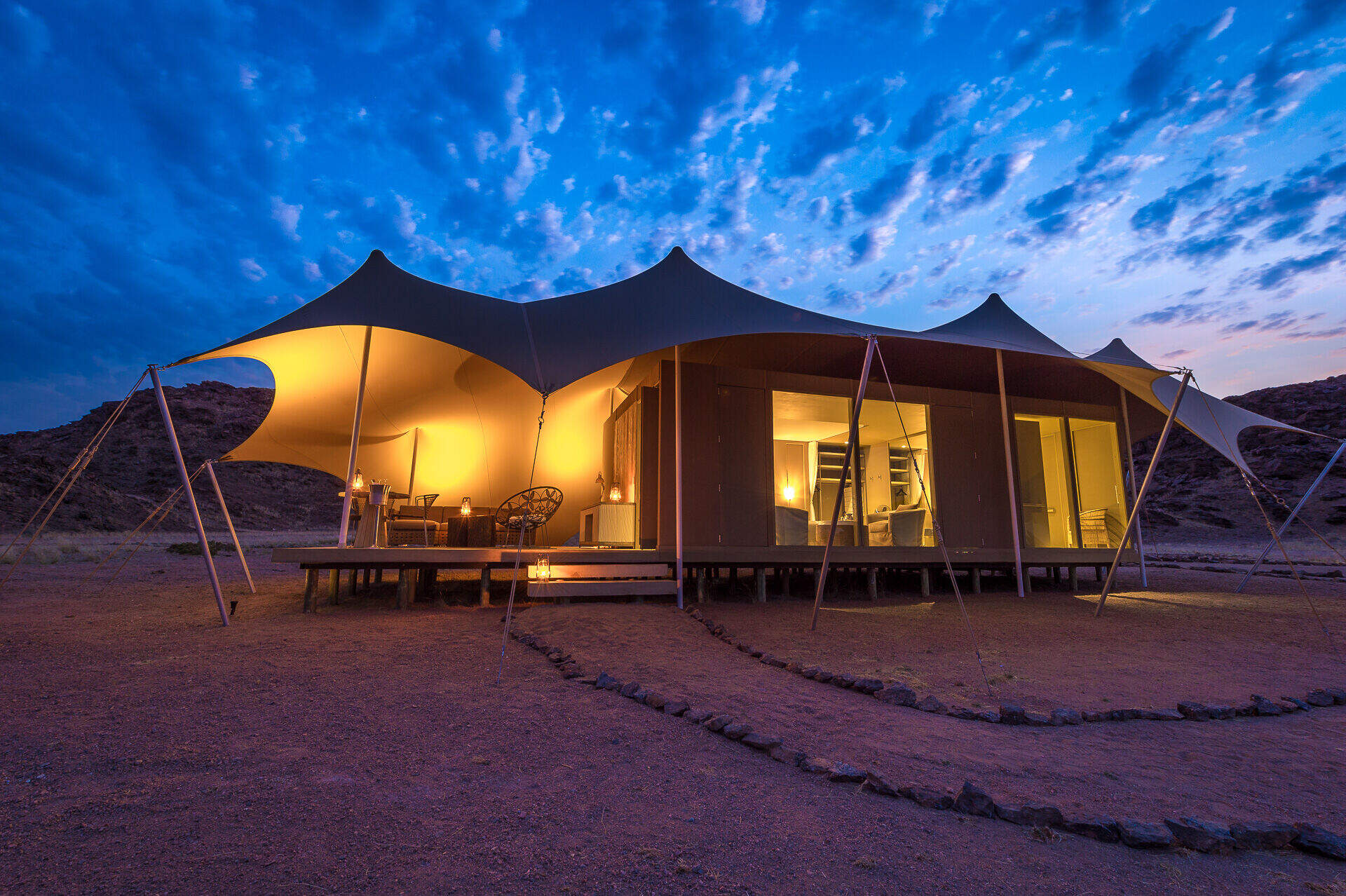
Okaukuejo Camp
Okaukuejo Camp's large permanent waterhole can attract vast numbers of animals coming to quench their thirst. Black rhinos, zebras, lions and herds of elephant are frequent visitors in the evenings, and guests have stunning opportunities to observe them at close range.
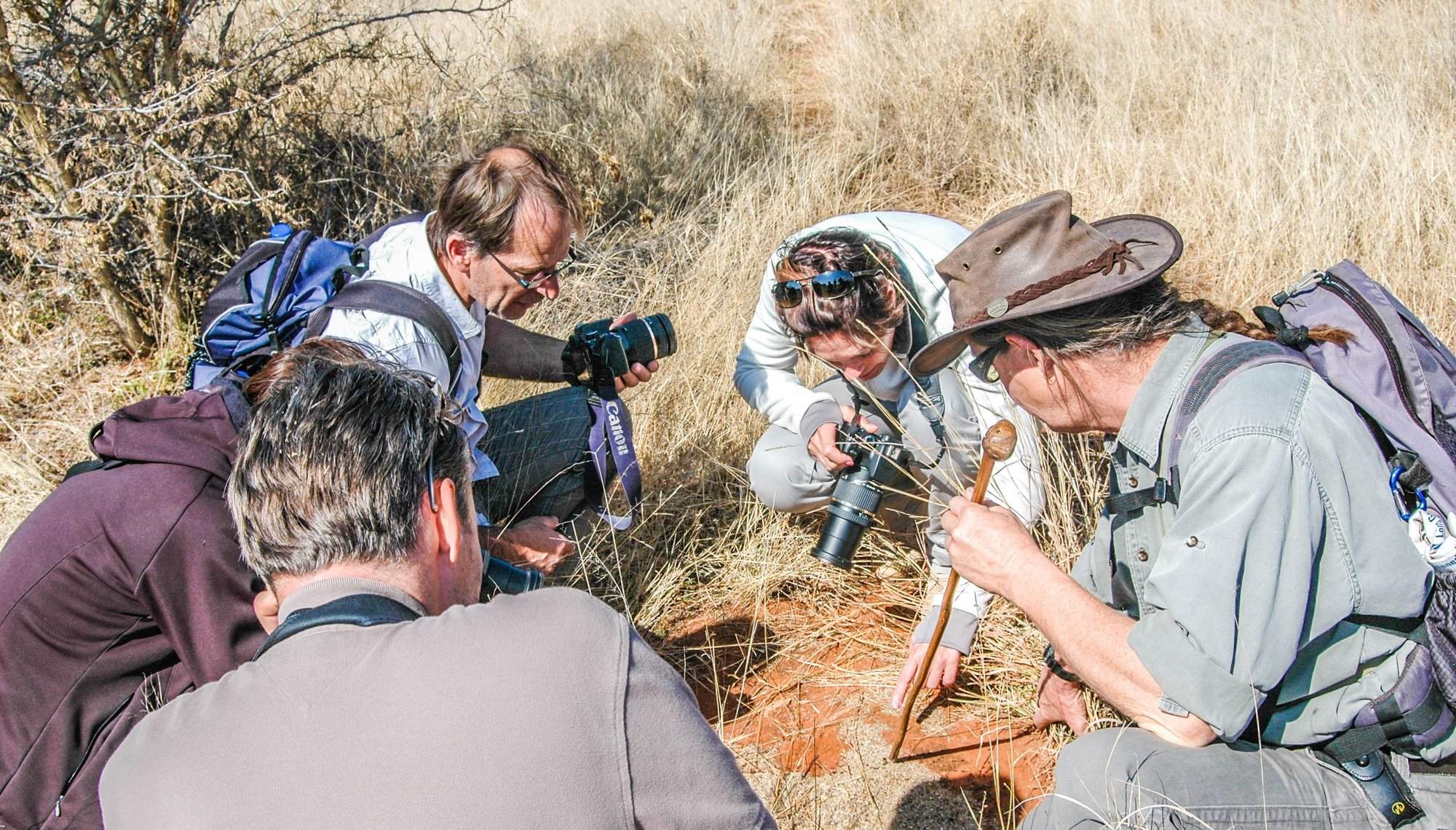
Kaza Safari Lodge
The motor-boat trips along the Chobe and Zambezi rivers are excellent for seeing wildlife. On our last visit here, when we took a boat trip along the Chobe Riverfront, we spotted lion, sable, buffalo, elephant, puku, giraffe, elephant and warthog!
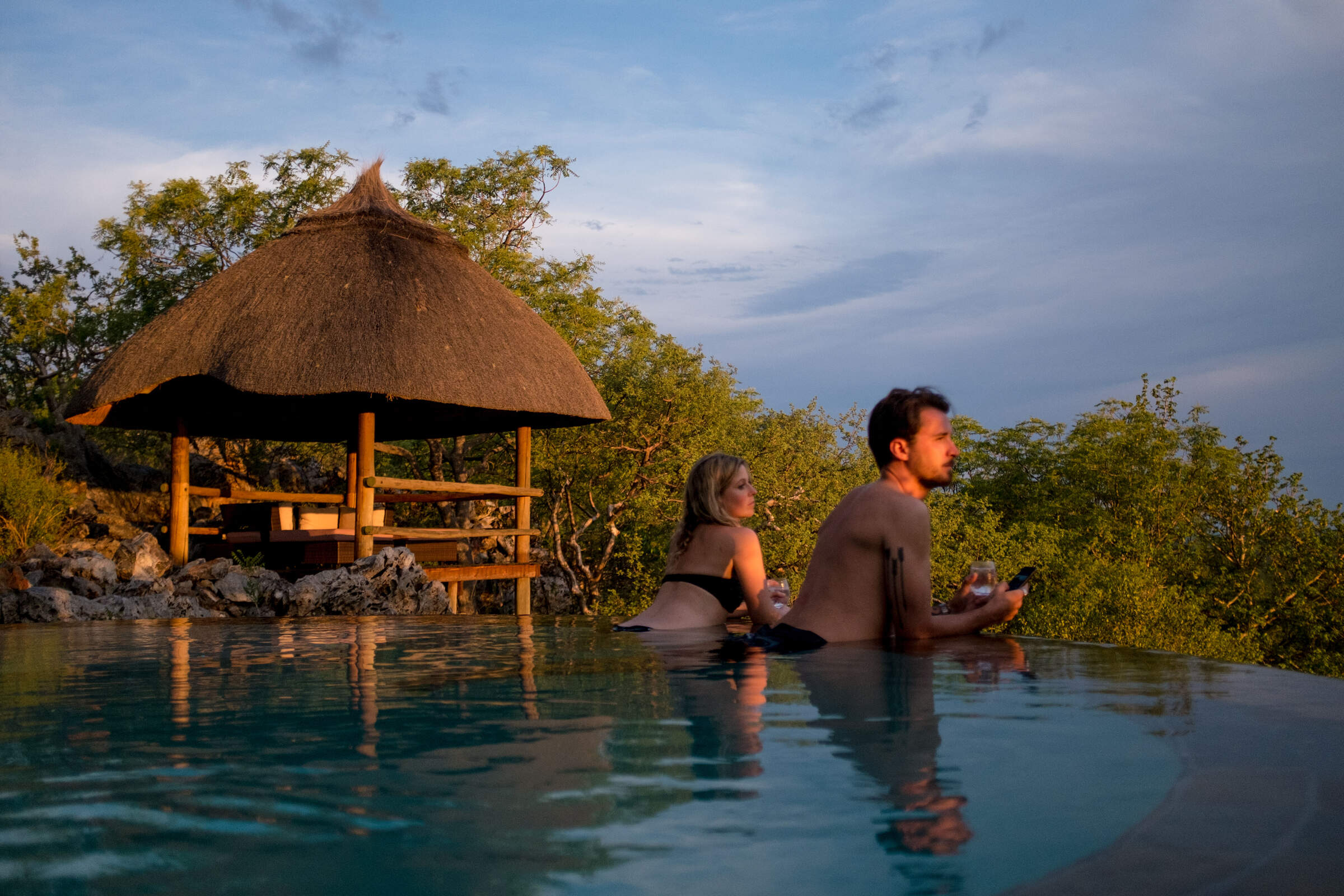
Onguma The Fort
Onguma The Fort is blessed with a prime location on the Onguma Private Reserve overlooking Fischer’s Pan, and is adjacent to the wildlife rich Etosha National Park, so game viewing from here is of the highest order.

Okonjima Villa
The exclusive Okonjima Villa has the added bonus of a location within the main reserve. For a great end to a safari in Namibia, keep watch at the waterhole, and expect to be able to view big cats at close quarters.
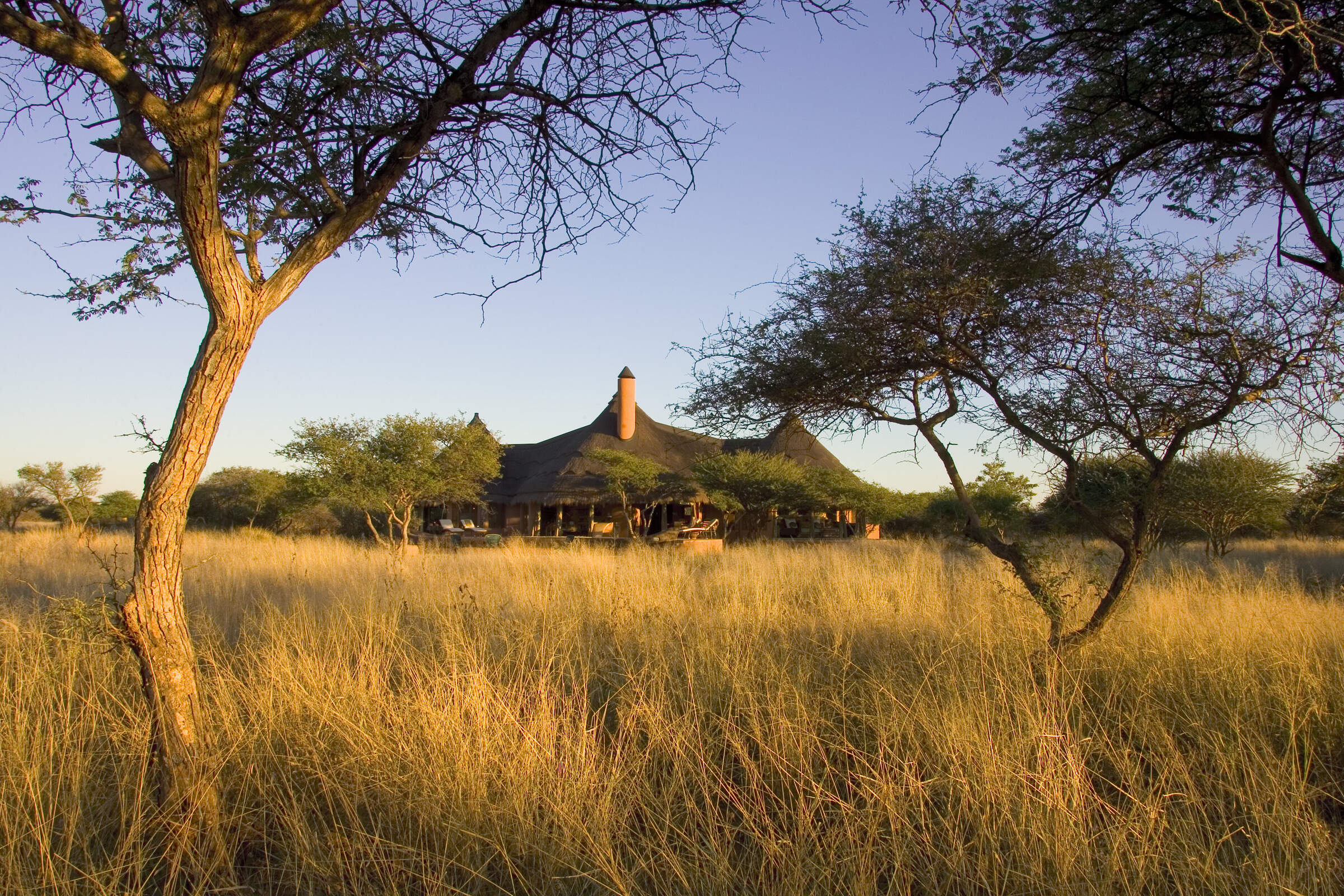
Okonjima Bush Suite
Visitors on a Namibia wildlife safari at Okonjima Bush Suite have the opportunity to find out about the work of AfriCat, and will have a private guide to see at close quarters the big cats they fight to protect.
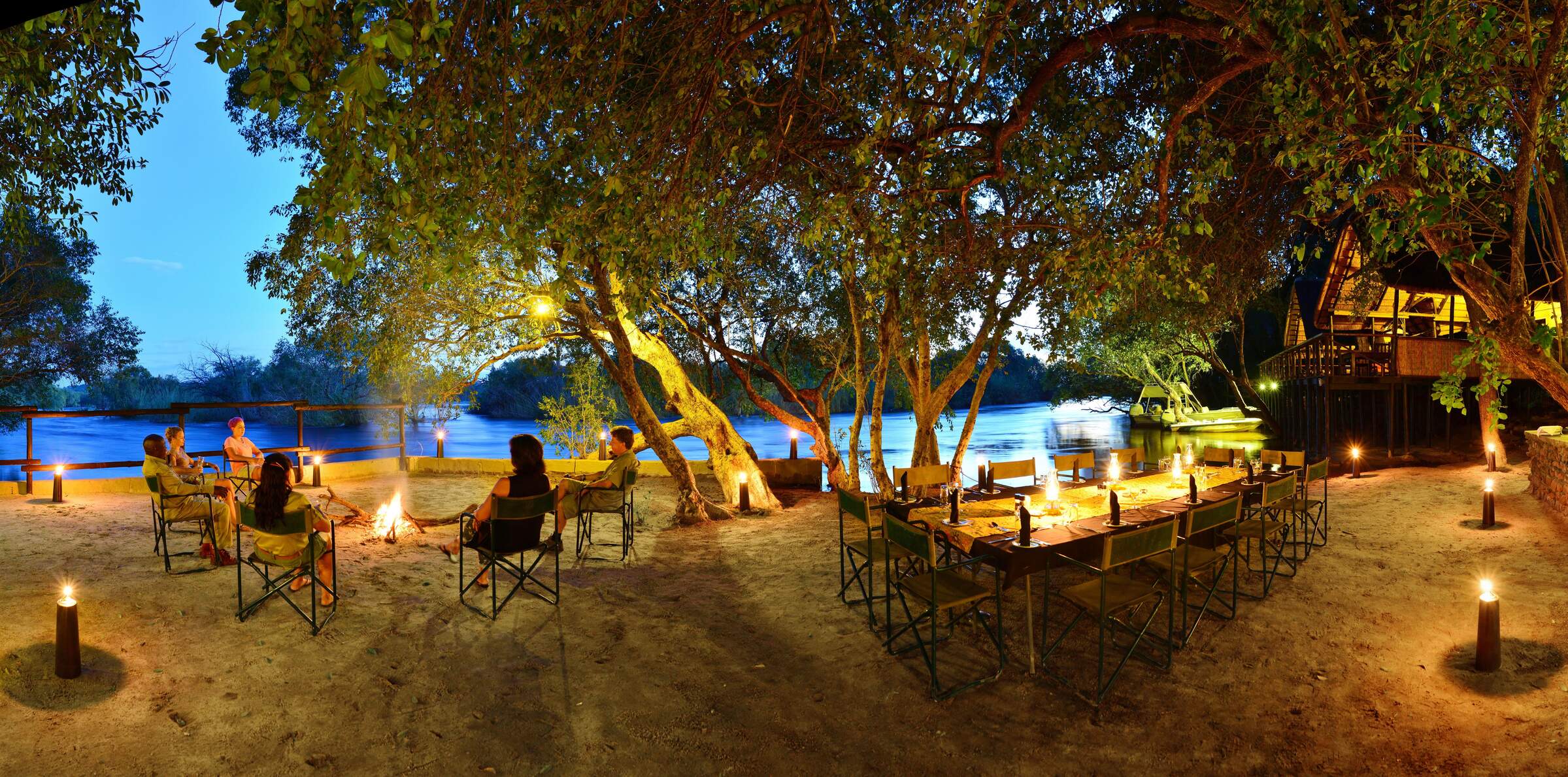
Ichingo Chobe Lodge
Ichingo's motor-boat trips along the Chobe and Zambezi rivers are excellent for birdlife and general river-based wildlife – and relaxed big game is also often seen from the waterfront of Chobe National Park.

Onguma Bush Camp
Onguma Bush Camp is in a superb location for venturing into the wildlife rich Etosha National Park and is especially good for those travelling with children who are well catered for here.
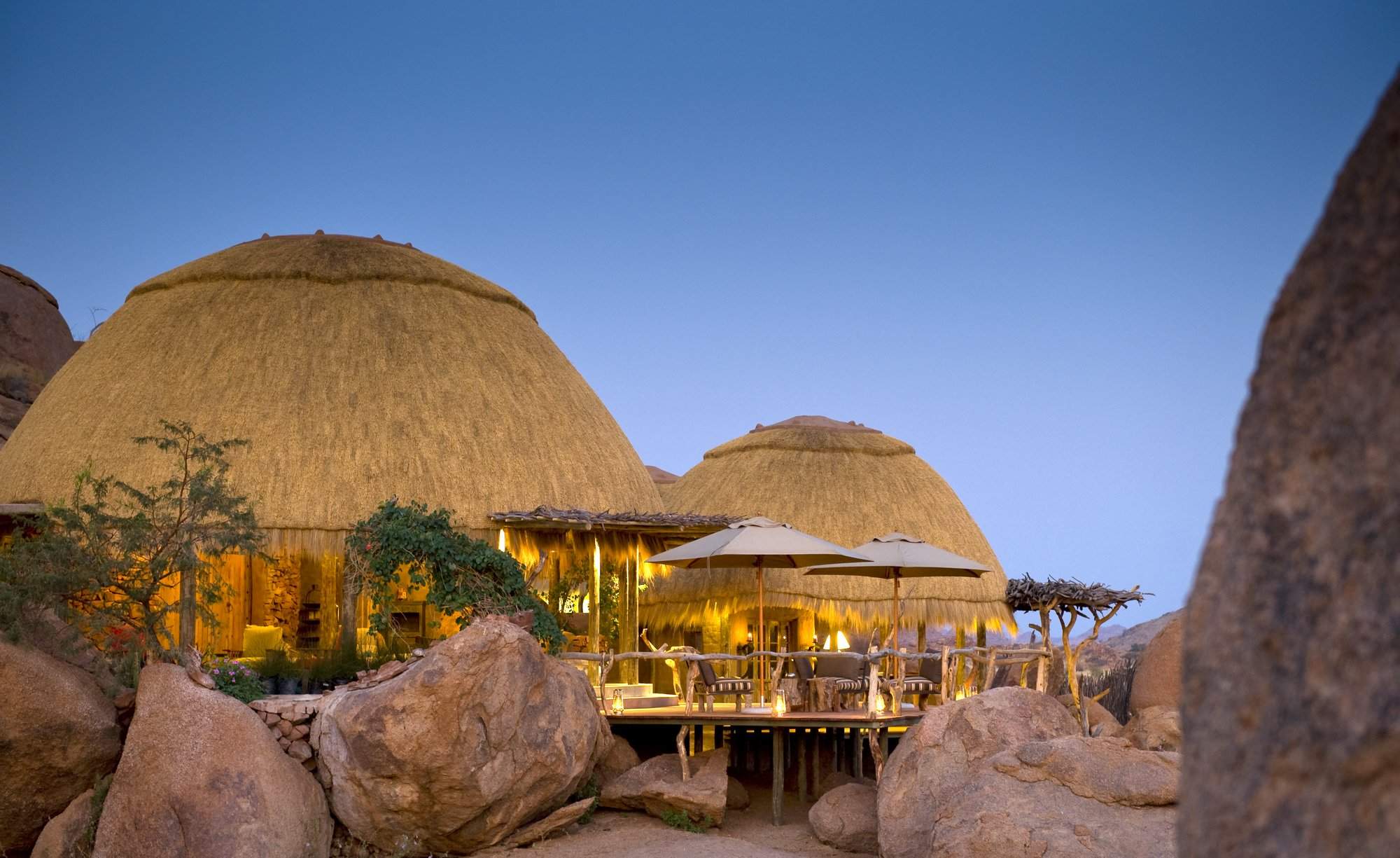
Onguma Camp Kala
Within easy access of Etosha National Park, the small, intimate Onguma Camp Kala is a lovely place to stay for a good safari experience.
Best camps & lodges for Wildlife safaris in Africa
Wildlife safaris elsewhere in Africa
Our top ideas and inspiration for Wildlife safaris in other countries.
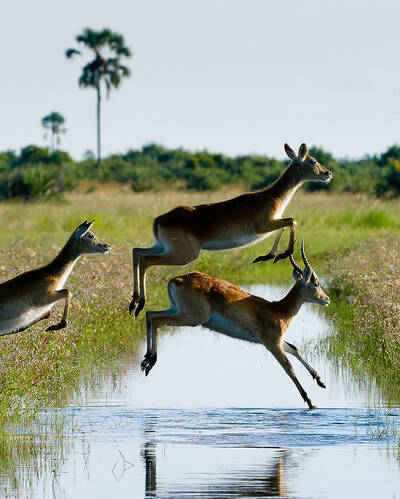
Botswana's wildlife safaris are perhaps the best in Africa: the vast reserves are usually un-fenced, ...
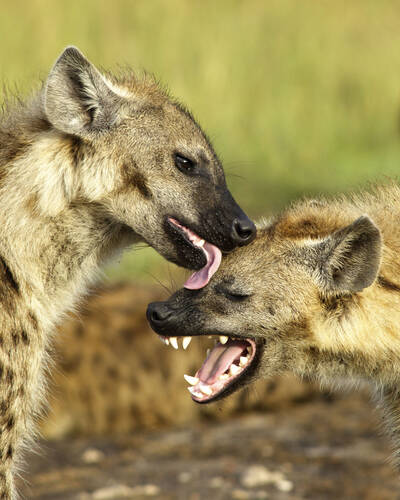
Kenya is the country where the word 'Safari' (Swahili for 'journey') actually comes from. Close ...
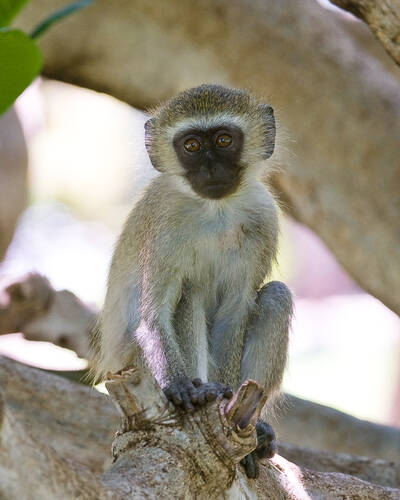
Don't expect spectacular game on a wildlife safari in Malawi, instead come for a relaxed safari ...
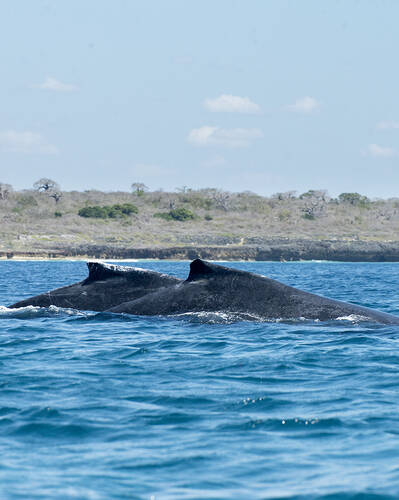
Mozambique is best known for its wonderful beaches and marine life, not its 4WD safaris. There ...
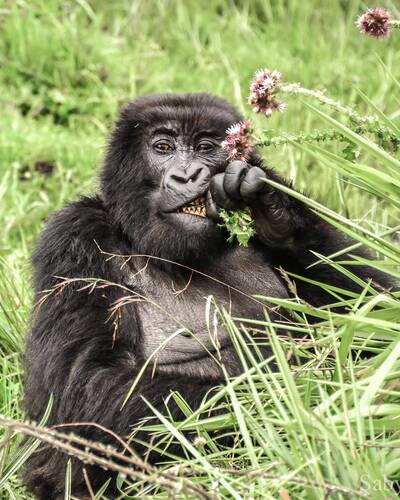
Having walked since dawn, you're tired but your senses are alive. You hear them grunt before you ...
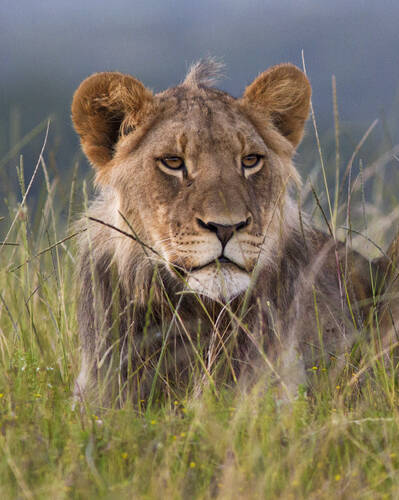
South Africa
Expert Africa covers only the western side of South Africa, including the Cape and Kgalagadi. Within ...
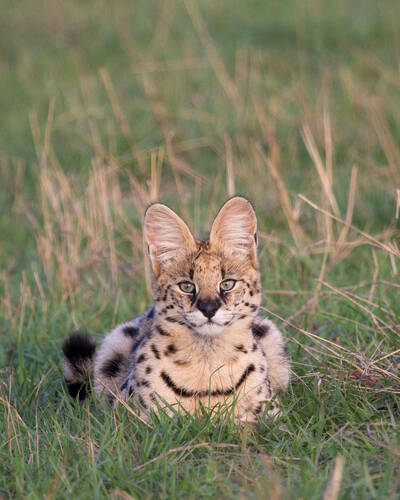
Tanzania offers a winning combination: some of Africa's best wildlife safaris plus stunning tropical ...
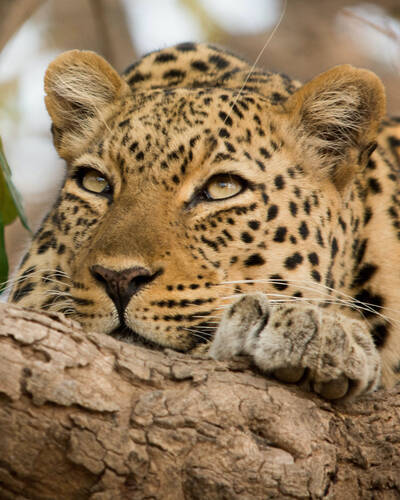
For all of the Zambia specialists at Expert Africa, wildlife safaris are the core of what we do: ...
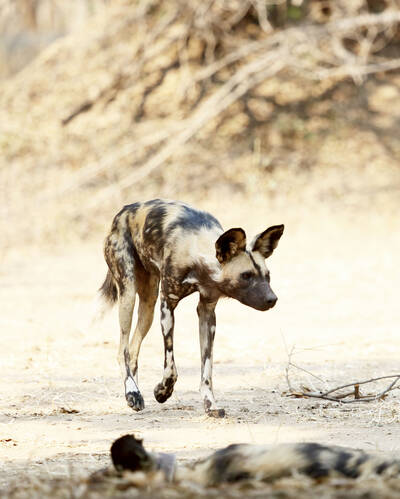
If watching wildlife from a 4WD is not close enough for you, then go on a wildlife safari in Zimbabwe! ...
Where to see wildlife species in Namibia
Maximise the chances of seeing your favourite animals based on traveller sightings reports from the field.
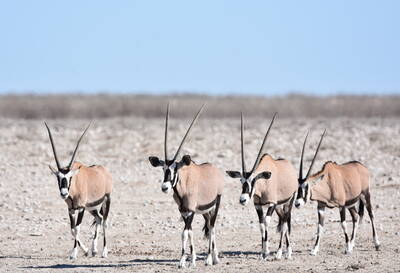
Oryx are impressive antelopes, with a powerful physique and elegant markings set off by rapier-like horns. They cut a distinctive dash in some of Africa’s harshest landscapes.
70% SUCCESS
1,336 sightings from 1,916 observations
Where to see oryx in Namibia
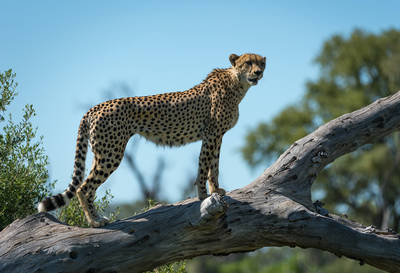
Acinonyx jubatus
The cheetah is the fastest land animal and the only cat that hunts by pure speed. Found largely in open grasslands, its slim, elegant form is today an increasingly rare sight.
33% SUCCESS
1,052 sightings from 3,200 observations
Where to see cheetah in Namibia
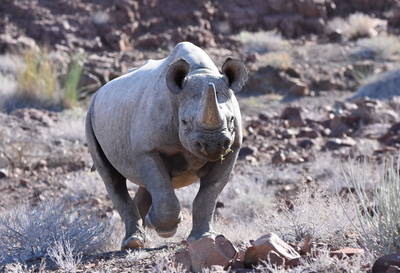
Black Rhino
Diceros bicornis
The black rhino is the smaller and rarer of Africa’s two rhino species but has the more fearsome reputation. Shy and heavily persecuted, it tends to stick to cover.
30% SUCCESS
626 sightings from 2,060 observations
Where to see black rhino in Namibia
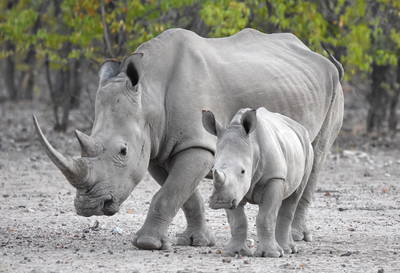
White Rhino
Ceratotherium simum
The white rhino is the largest and most numerous of the world’s five rhinoceros species. They are larger, easier to see and generally more approachable than the black rhino.
44% SUCCESS
497 sightings from 1,140 observations
Where to see white rhino in Namibia
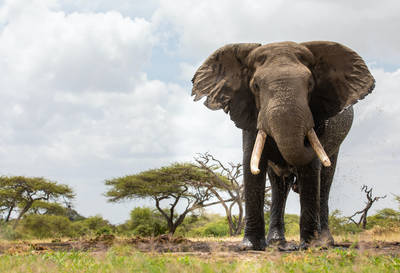
Loxodonta africana
By far the biggest of the so-called Big Five – indeed, the largest land animal on the planet – the elephant shapes the very landscape it inhabits and is a defining presence on any safari.
91% SUCCESS
3,652 sightings from 4,020 observations
Where to see elephant in Namibia
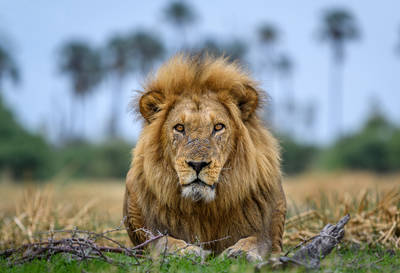
Panthera leo
Lions are at the top of the food chain and also most safari wish-lists, but with their numbers falling fast, any encounter with these majestic apex predators always feels like a privilege.
81% SUCCESS
3,050 sightings from 3,757 observations
Where to see lion in Namibia
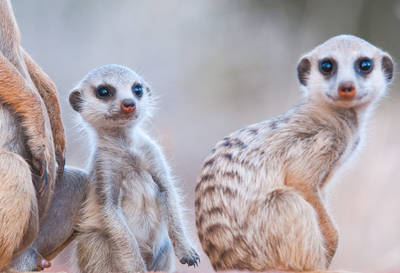
Suricata suricatta
These highly sociable little mammals have an endearing appearance and comical antics. Found in the drier areas of Southern Africa, close encounters are a sought-after experience.
21% SUCCESS
88 sightings from 417 observations
Where to see meerkat in Namibia
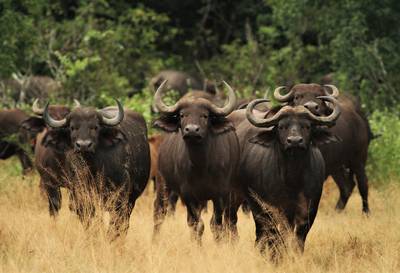
Syncerus caffer
One of the ‘Big Five’, buffalo earned a fearsome reputation in hunters’ tales. By contrast, big herds of these sociable bovids are placid, but mount formidable defences against predators.
83% SUCCESS
2,575 sightings from 3,109 observations
Where to see buffalo in Namibia
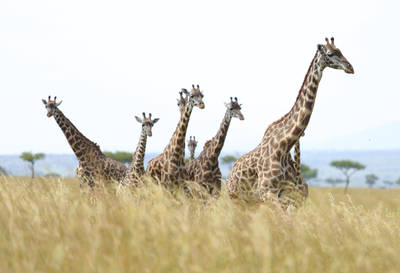
Giraffa camelopardalis
The world’s tallest land mammal, giraffes are herbivores which have evolved many unique adaptations. Their iconic outlines tower above the bush in many of Africa’s wildlife areas.
86% SUCCESS
3,525 sightings from 4,098 observations
Where to see giraffe in Namibia
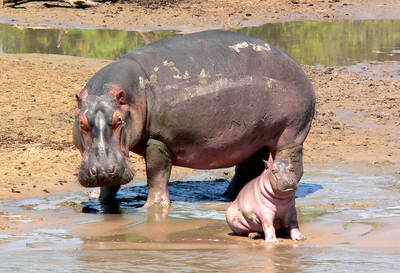
Hippopotamus amphibius
The territorial calls of the hippo create a signature soundtrack to Africa’s rivers & wetlands. Despite an endearing smile, this aquatic herbivore has a notoriously aggressive disposition.
89% SUCCESS
2,668 sightings from 2,992 observations
Where to see hippo in Namibia
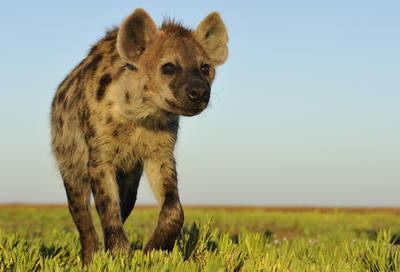
Spotted Hyena
Crocuta crocuta
The spotted hyena may be thought of as ‘ugly’ and ‘cowardly’. In fact, this versatile and intelligent carnivore is one of Africa’s most fascinating and warrants attention on any safari.
55% SUCCESS
2,183 sightings from 3,967 observations
Where to see spotted hyena in Namibia
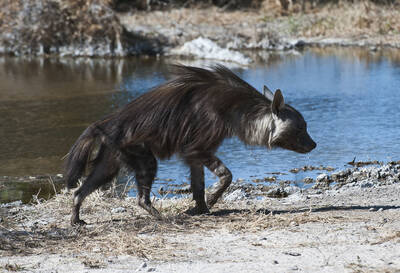
Brown Hyena
Parahyaena brunnea
This largely solitary scavenger is one of the more elusive and little-known of Africa’s carnivores. Shaggier than its spotted cousin, it occurs only in the arid southwest of the continent.
16% SUCCESS
246 sightings from 1,529 observations
Where to see brown hyena in Namibia
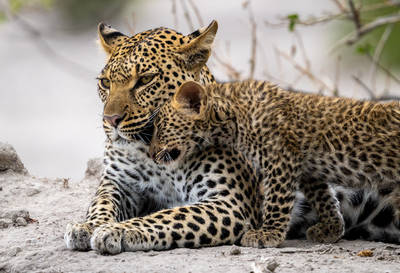
Panthera pardus
The most numerous of Africa’s big cats, leopard occur across many habitats, from wild tracts to populated areas. Their grace and their elusive nature make them a unique safari drawcard.
47% SUCCESS
1,952 sightings from 4,167 observations
Where to see leopard in Namibia
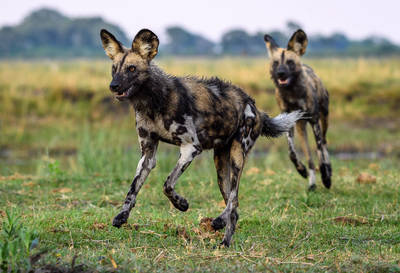
Lycaon pictus
African wild dogs are among the continent’s most compelling animals. Much misunderstood, these rare, tie-dyed canids are amazingly efficient hunters with a fascinating social life.
32% SUCCESS
880 sightings from 2,790 observations
Where to see wild dog in Namibia
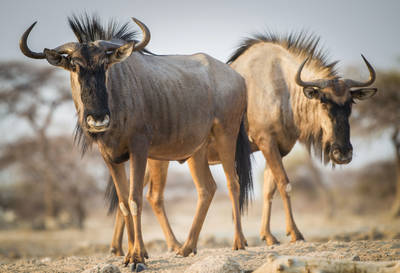
Connochaetes sp.
Superficially bovine in appearance, wildebeests are known for their spectacular migrations sometimes in huge numbers. These resilient animals are some of Africa’s most successful herbivores.
68% SUCCESS
2,499 sightings from 3,691 observations
Where to see wildebeest in Namibia
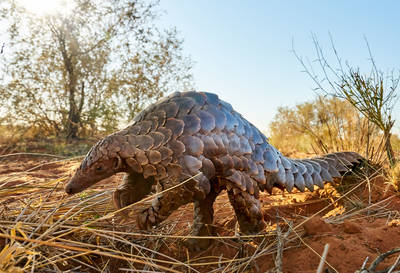
Smutsia sp.
Pangolins appear to be more pine cone than animal in their unique armoury of scales. These nocturnal, ant-eating oddities are not only highly elusive but also increasingly rare.
55 sightings from 3,345 observations
Where to see pangolin in Namibia
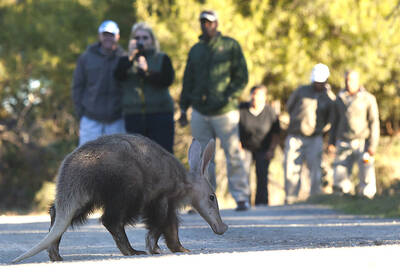
Orycteropus afer
The aardvark is one of Africa’s most bizarre and enigmatic animals. A shy, nocturnal termite-eater, signs of its presence may be scattered about the bush whilst sightings remain elusive.
68 sightings from 3,338 observations
Where to see aardvark in Namibia
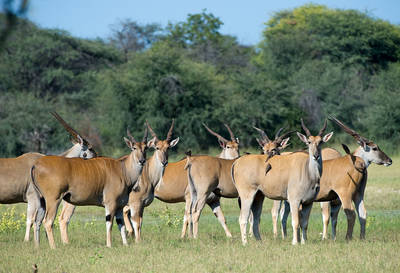
Taurotragus oryx
Africa’s largest antelope, eland are culturally important from prehistoric rock art to modern game farms. Though widespread, they are also shy so sightings are uncommon and often fleeting.
49% SUCCESS
1,467 sightings from 2,994 observations
Where to see eland in Namibia
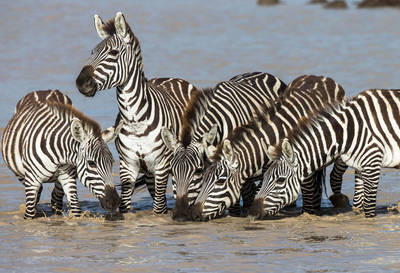
The zebra is a quintessential African animal: the horse in stripy pyjamas at the end of every child’s A–Z. There are three species, of which the plains zebra is much the most common.
84% SUCCESS
3,847 sightings from 4,572 observations
Where to see zebra in Namibia
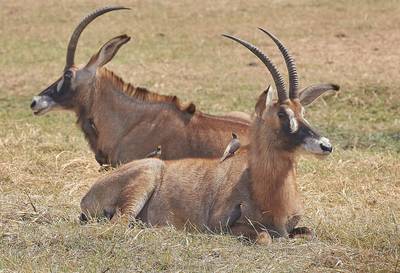
Roan antelope
Hippotragus equinus
Africa’s second largest antelope and one of its most handsome, with a powerful build and distinctive markings, roan are wary of people, but renowned for their bravery against predators.
24% SUCCESS
480 sightings from 2,040 observations
Where to see roan antelope in Namibia
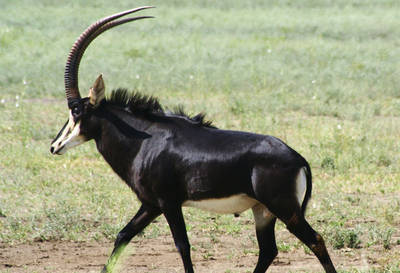
Sable antelope
Hippotragus niger
Perhaps Africa’s most beautiful antelope, sable are renowned for their combative nature, even holding off lions. Shy and restricted in range, sightings of sable are always special.
23% SUCCESS
460 sightings from 2,032 observations
Where to see sable antelope in Namibia
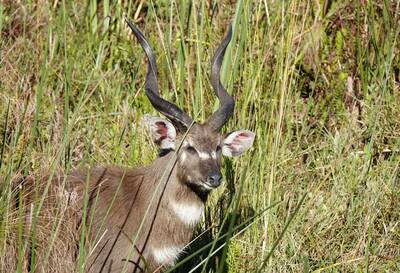
Tragelaphus spekii
The sitatunga is the most aquatic of Africa’s antelopes and specially adapted to its swampy habitats. Though widespread across Africa, only a handful of places offer reliable sightings.
19% SUCCESS
62 sightings from 334 observations
Where to see sitatunga in Namibia

Need inspiration?
Let our trip chooser narrow down the options for you
Other styles of holiday in Namibia
Discover all that Namibia has to offer
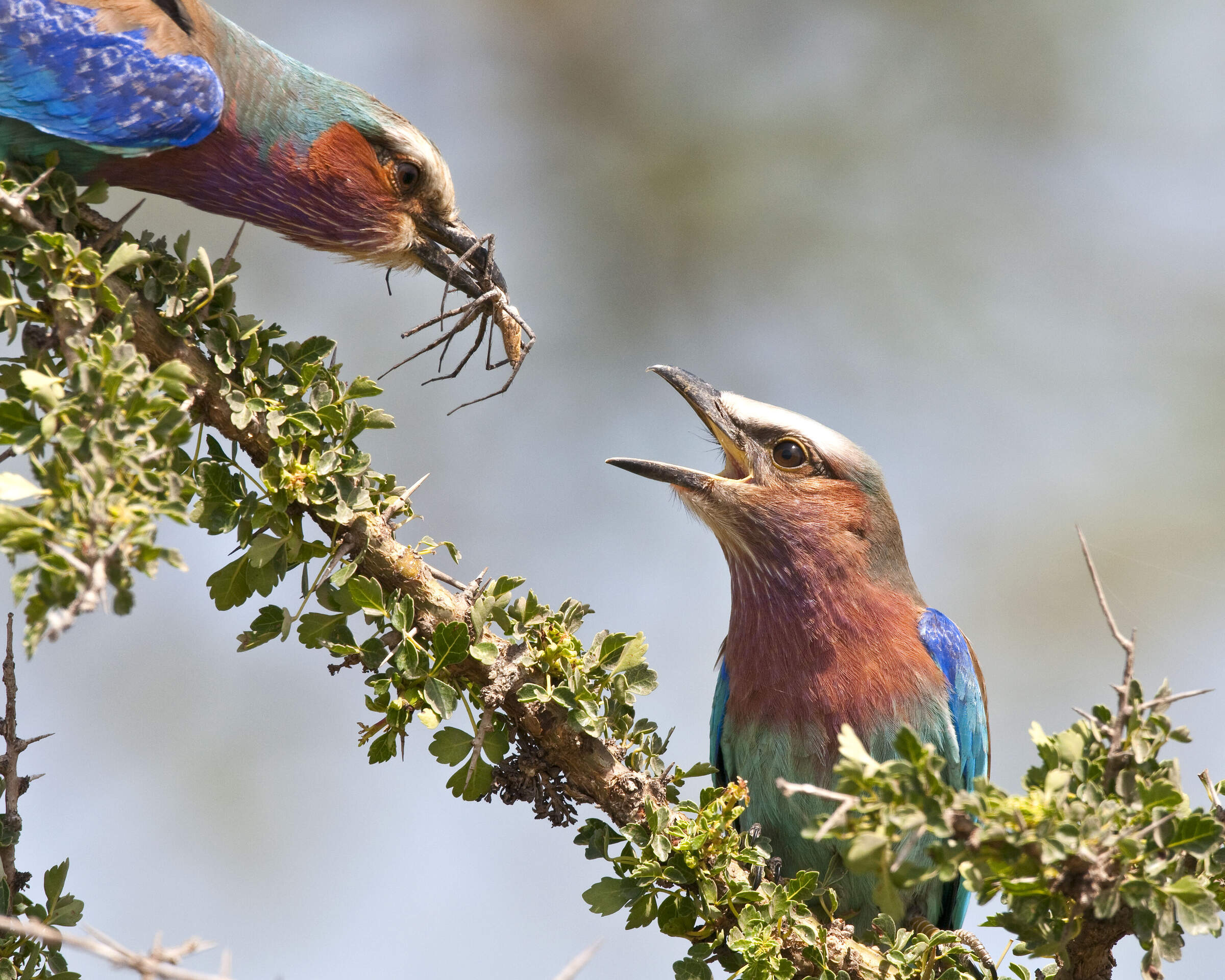
Birdwatching
Diverse habitats, discreet hides and superb guiding.
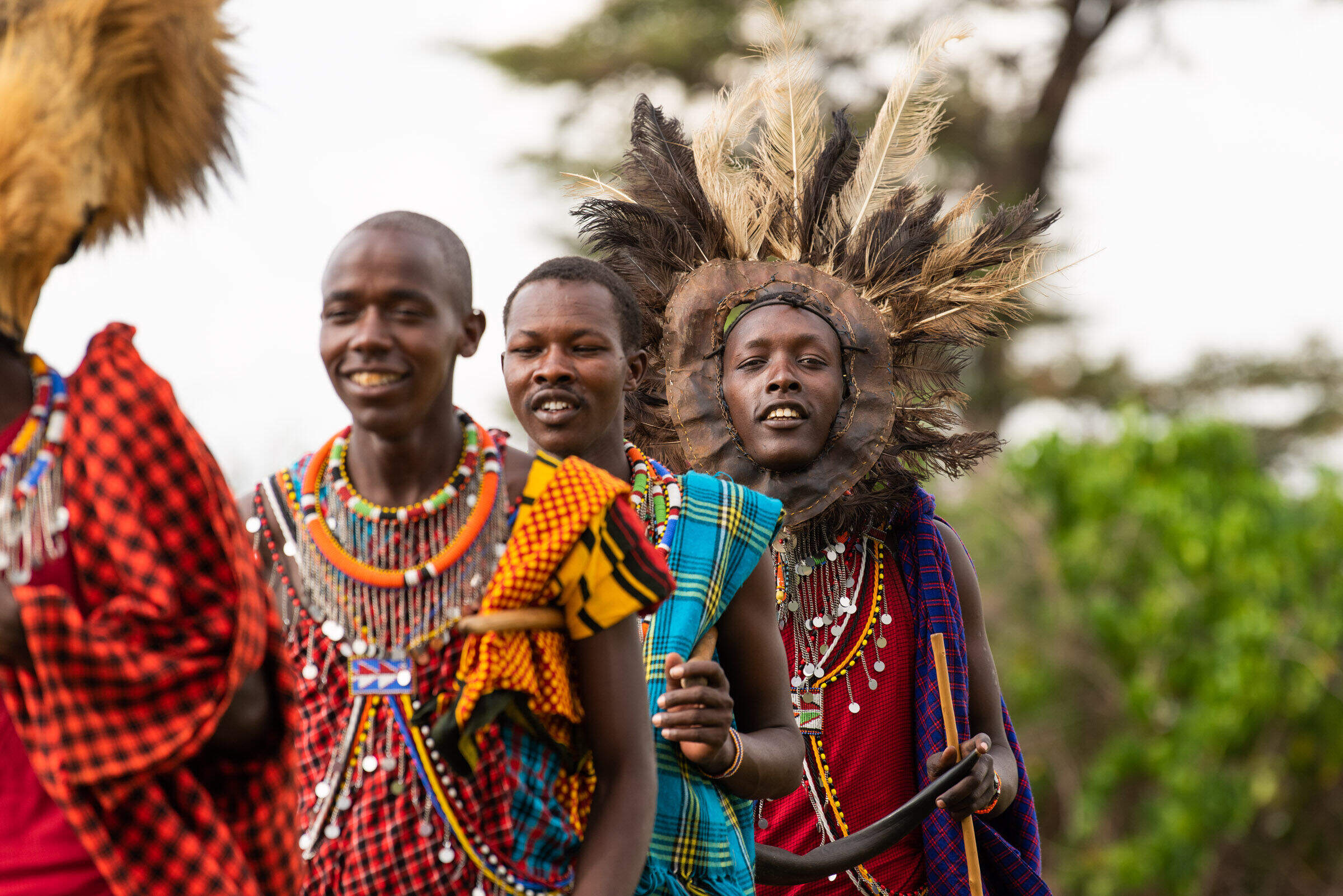
Cultural experiences
Get an insight into Africa's cultures and history.
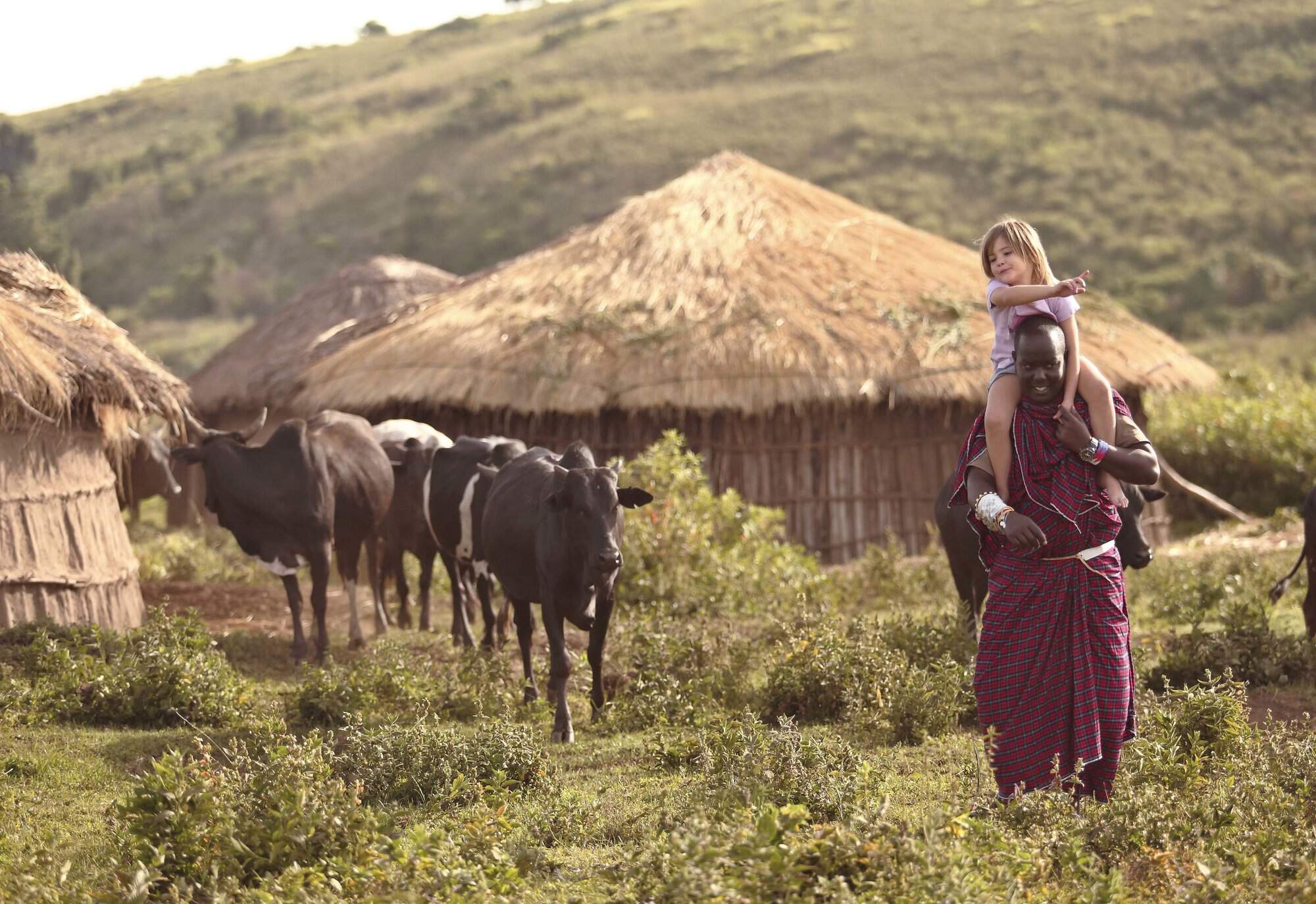
Family holidays
Hand-picked camps for an incredible family safari.
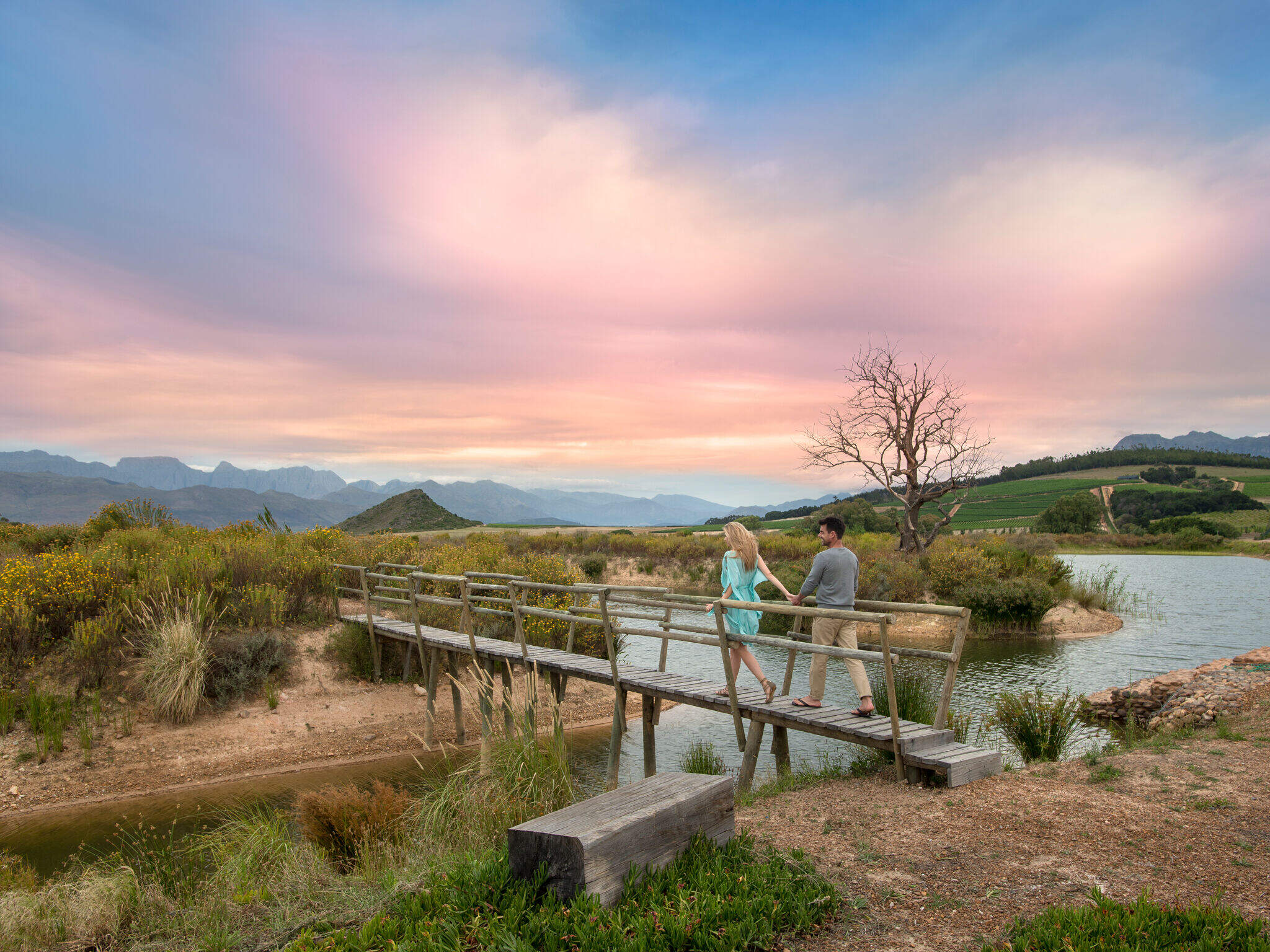
Romantic safaris and castaway island retreats.
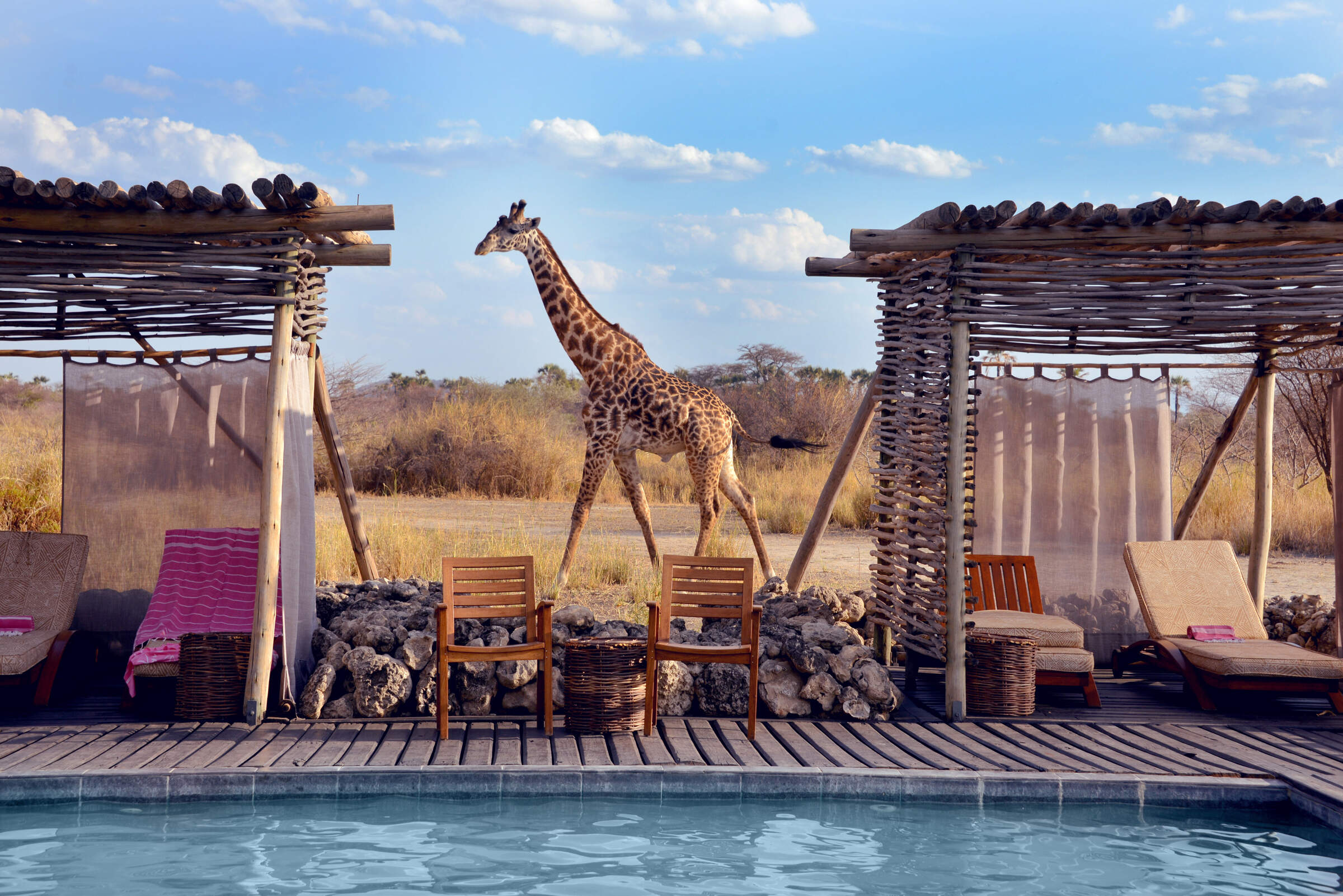
First-class service, scenic vistas and unparalleled comfort await you during these carefully selected luxury holidays.
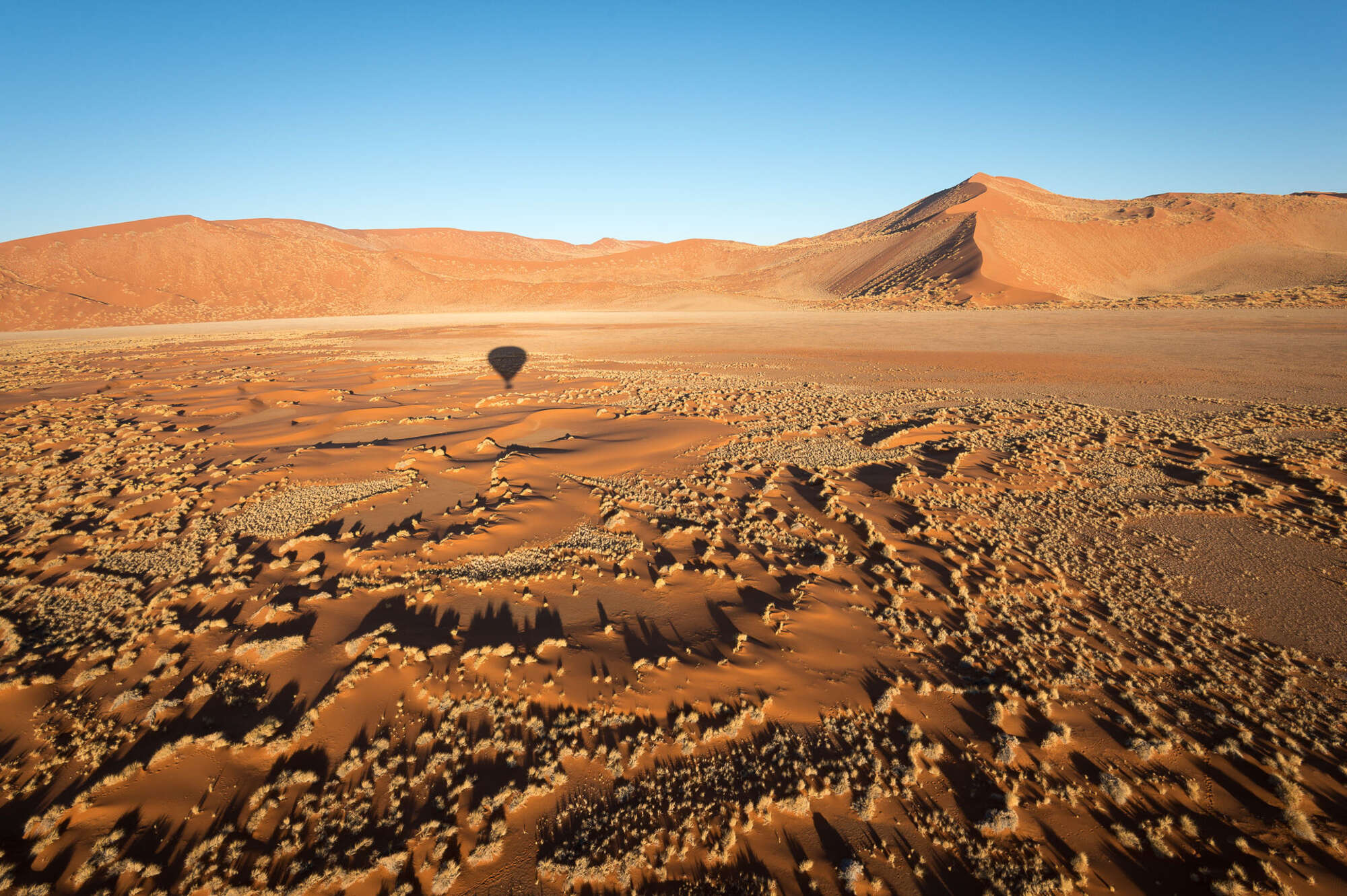
Photography holidays
Great holidays to suit the keen photographer.
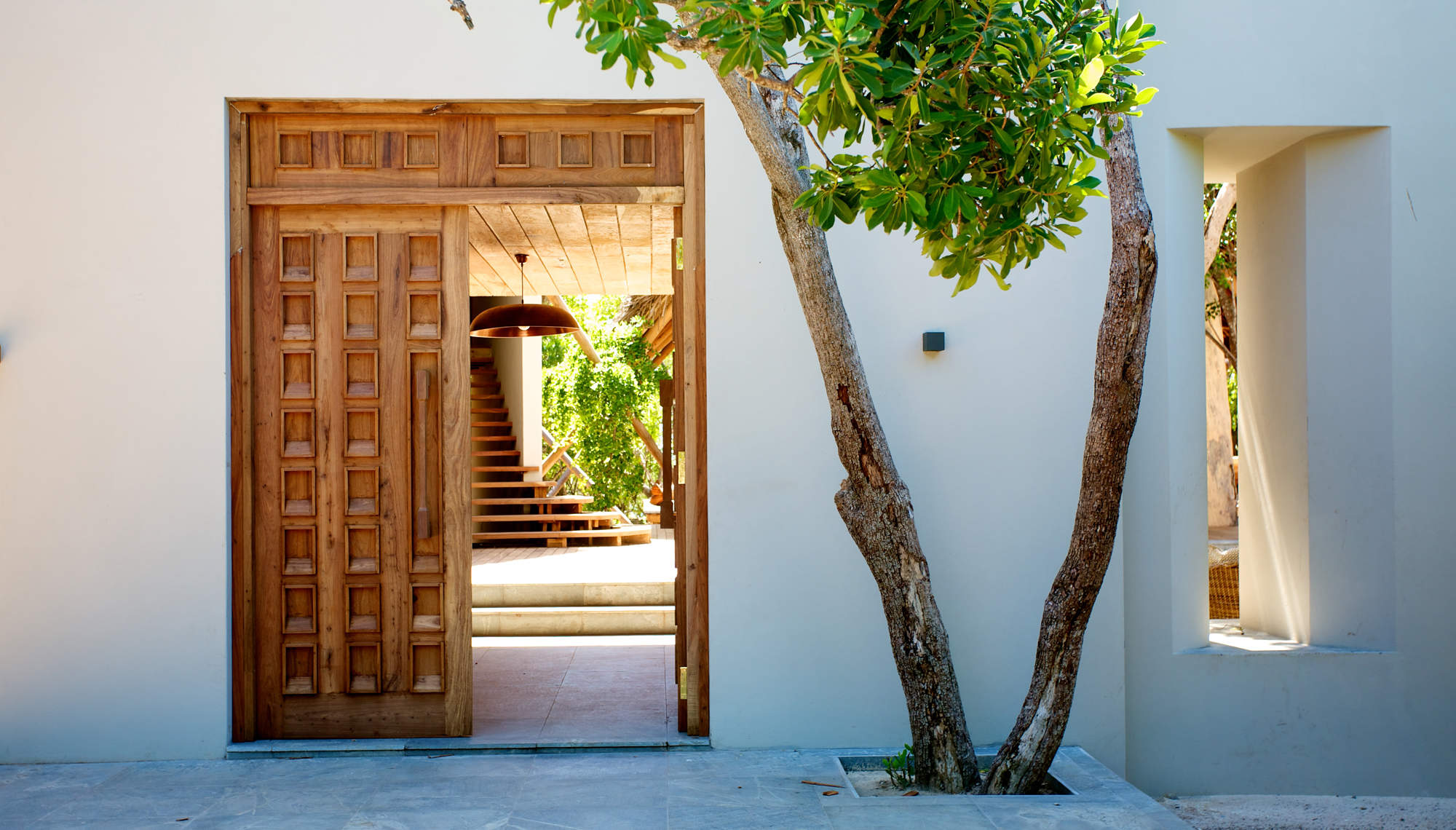
Private villas & houses
Enjoy Africa with just your friends & family
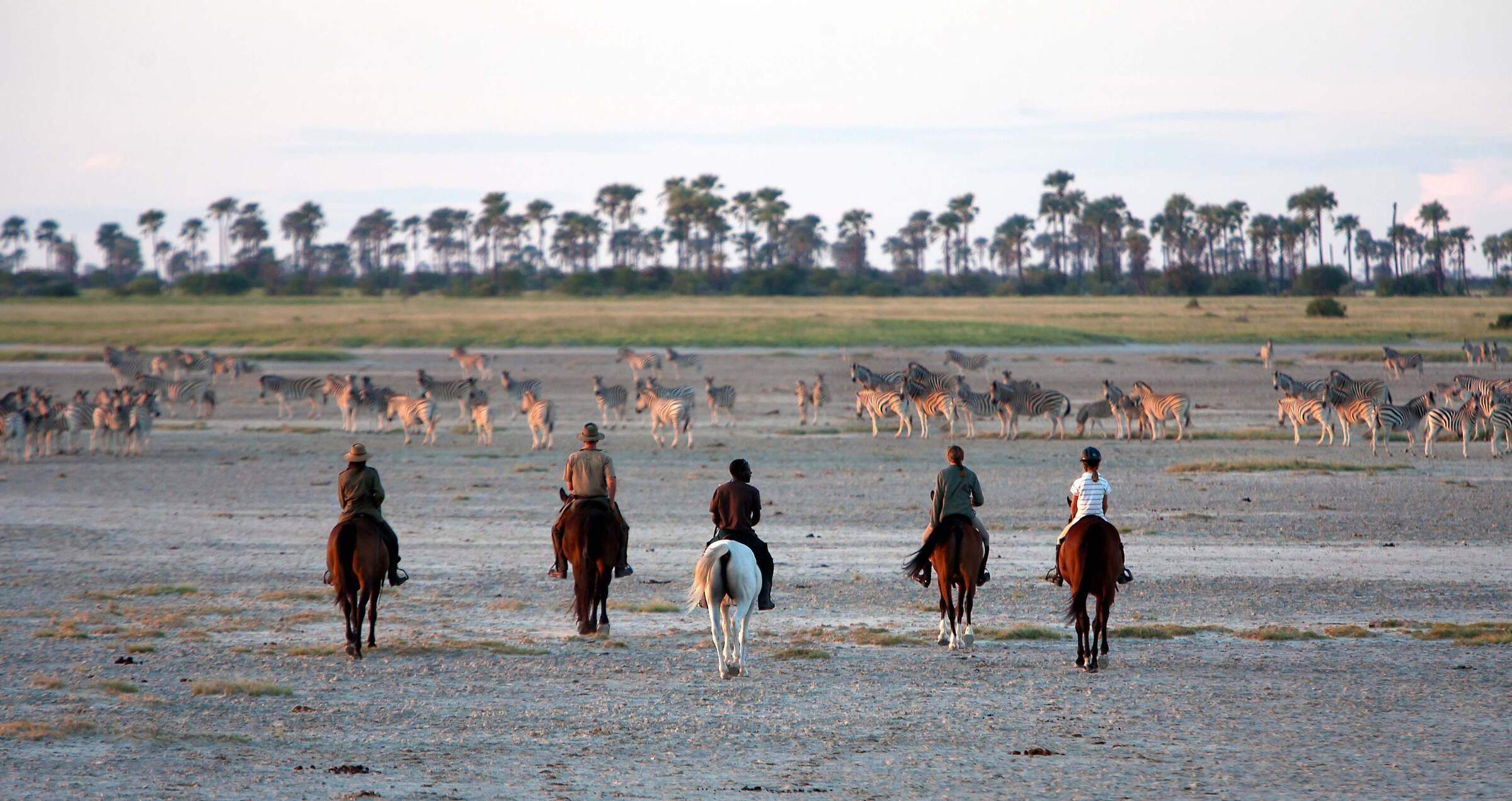
Riding holidays
Explore Africa's wilderness on horseback.
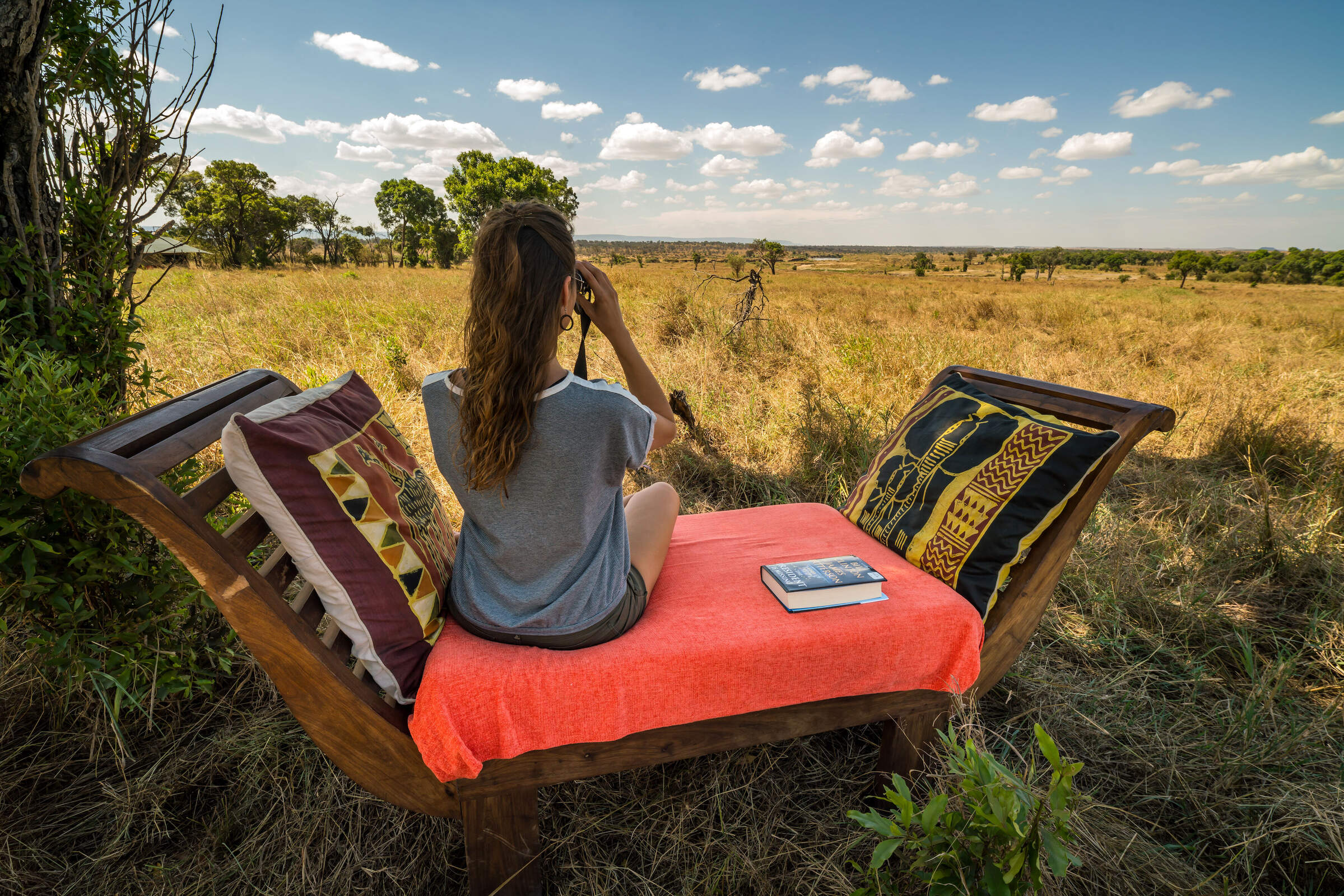
Solo Travel
Trip ideas ideally suited for a solo traveller.
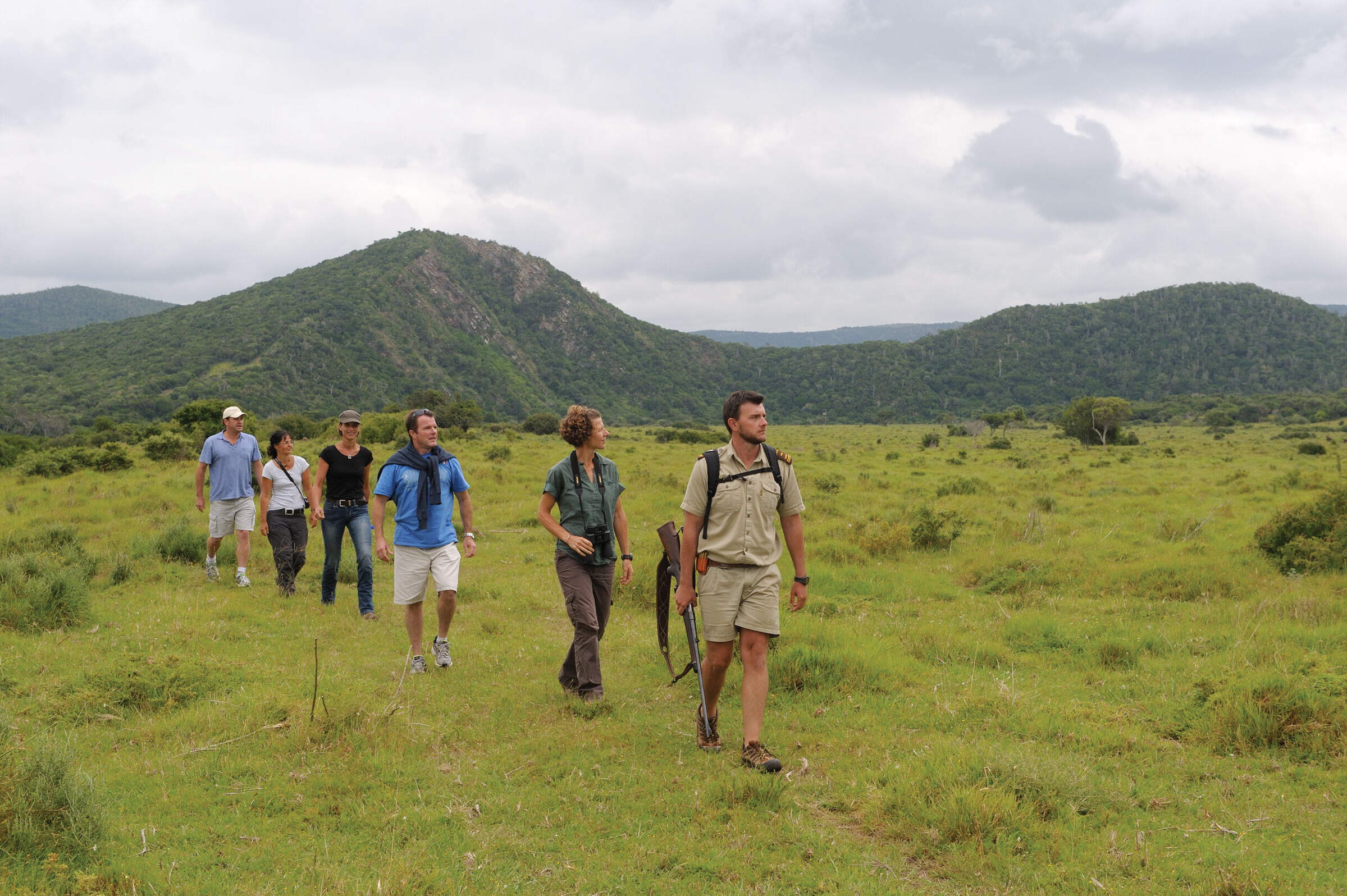
Explore Africa's most scenic trails on foot.
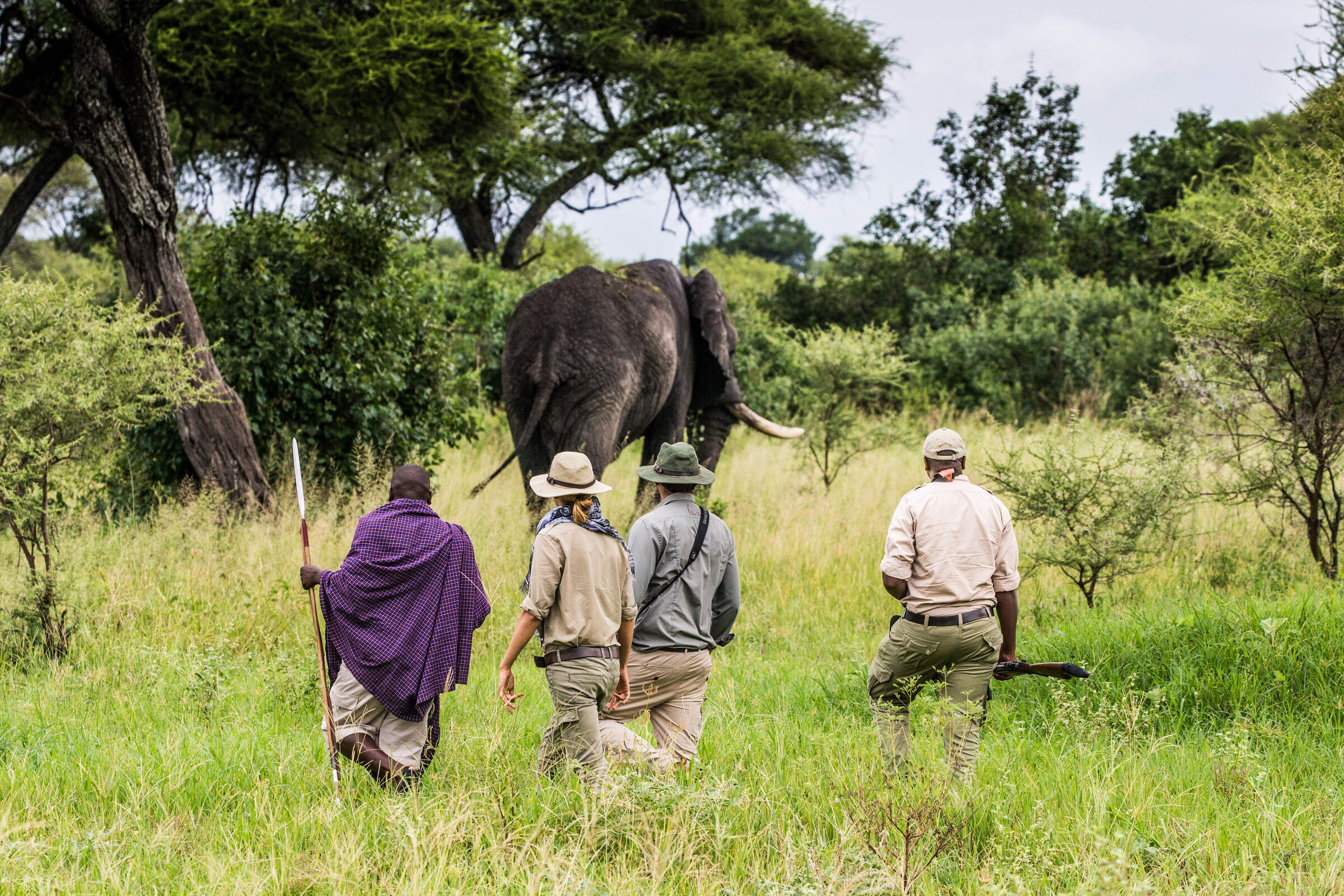
Walking safaris
Explore Africa's untouched wildernesses on foot.
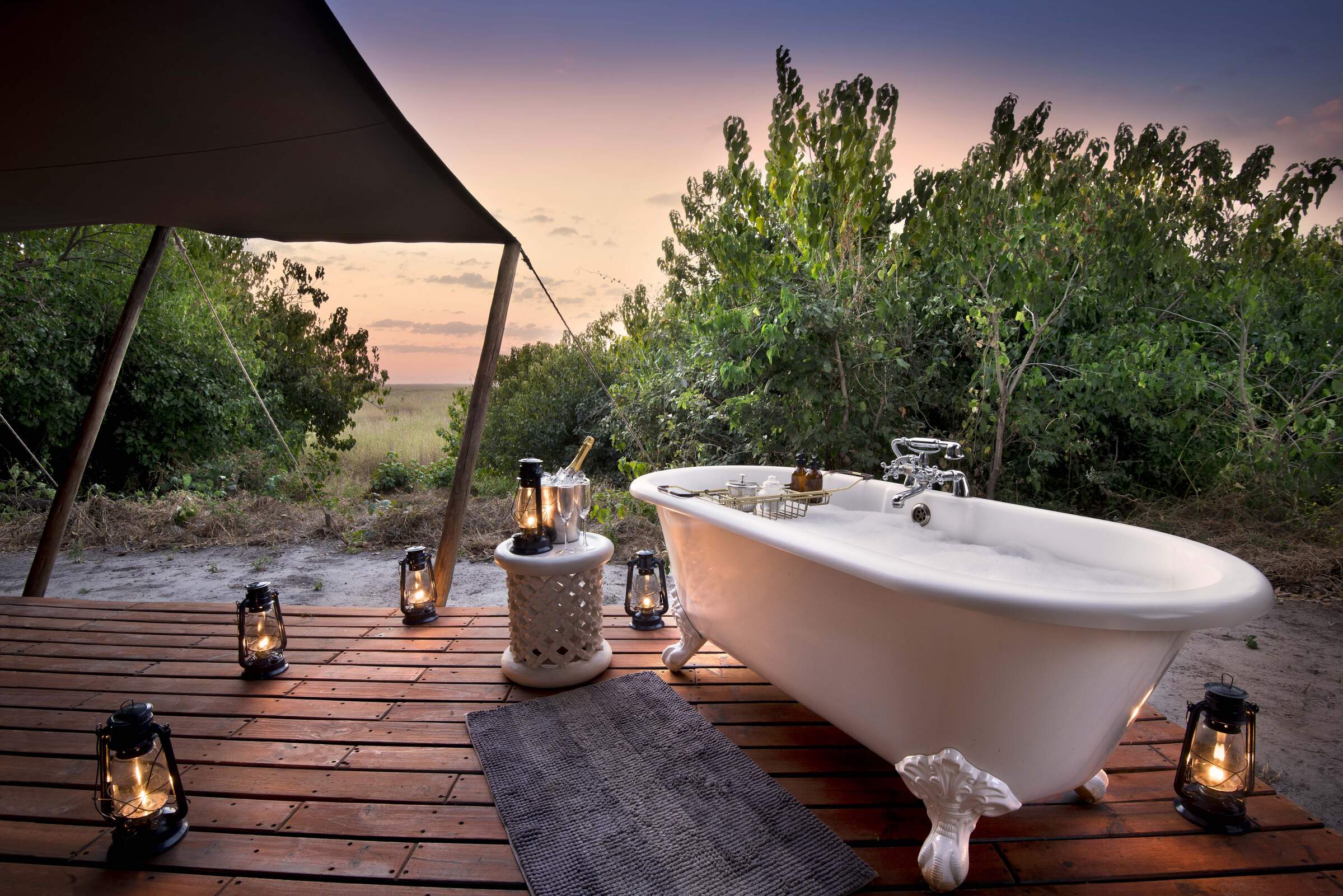
Wellness escapes in stunning locations
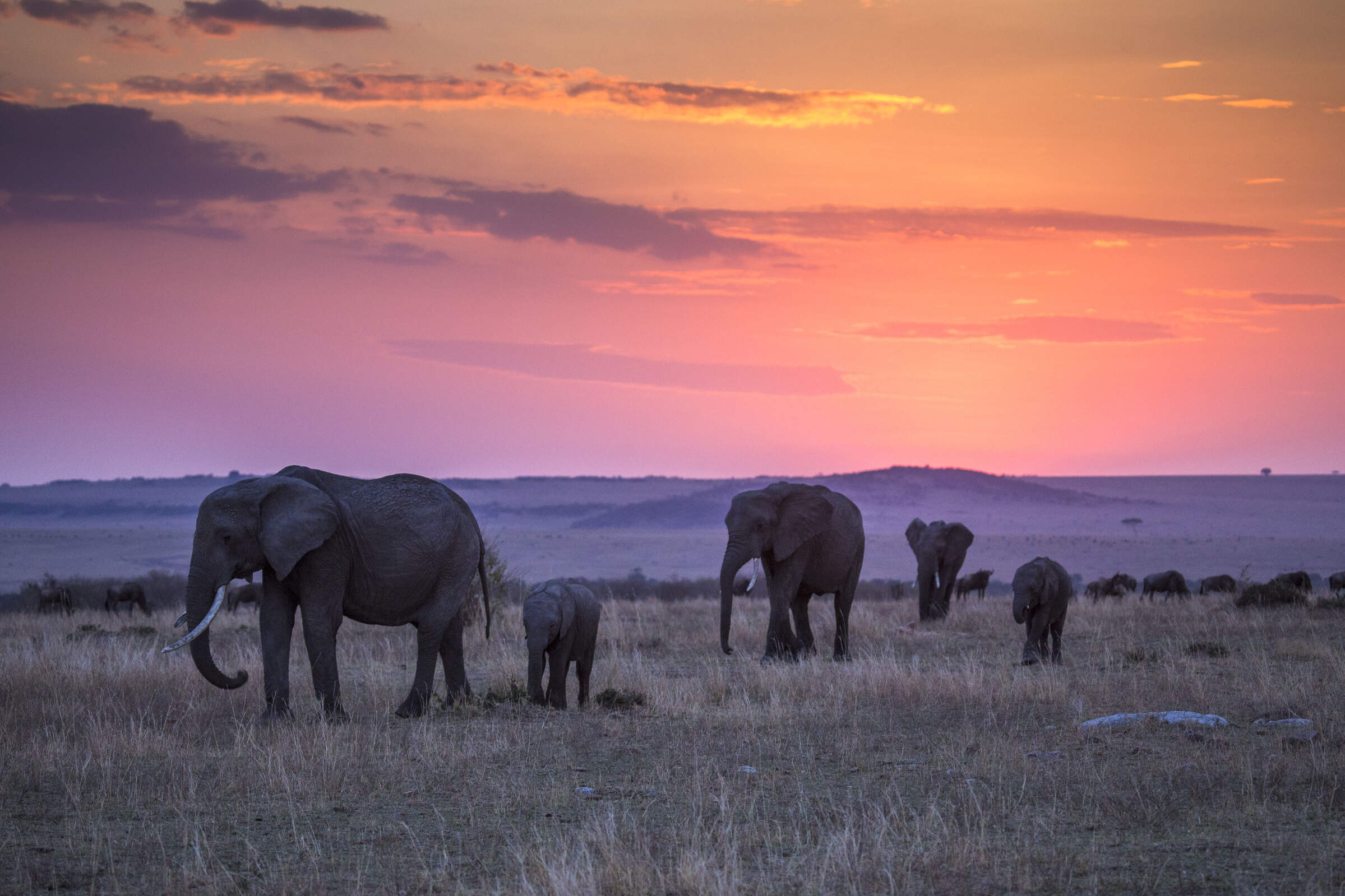
Wildlife safaris
These trips include hard-hitting game and fascinatingly elusive species alike, as well as superb guiding and a variety of diverse ecosystems.
Explore Namibia
Login to Expert Africa
Sign in with password
Sign in with email link
New to Expert Africa? Create an account
Forgotten your details?
It's free & quick to set up
- Save your wish-list
- Send us an enquiry
- Pay online for your trip
- Subscribe to our newsletter
- Give us feedback on your trip
- Full site benefits of the site
Need some help? Talk to our team
Delta & Falls Safari 8 days Departure on Friday Last day on Friday (Livingstone) & Sunday (Windhoek)
This safari has a guaranteed departure nearly every Sunday of the year. There are no minimum numbers and no single supplements. The price is virtually fully inclusive and the style is limited participation, assisted camping. Collection time is between 07:30 and 08:00 from anywhere within the Windhoek city limits. This itinerary can be linked to our 10 day Namibian Explorer Safari, our 7 day Northern Adventure Safari or our 7 day Southern Swing Safari. Additionally you can combine with our 3 day itineraries Etosha or Sossusvlei Link in order to carry you to some or all of the very best highlights that Namibia has to offer .
Day one Windhoek � Ghanzi Kalahari, Botswana (600 km) (LD) (camping)
A long drive today, making use of the Trans Kalahari Highway, a relatively new road that provides an invaluable communication link between Namibia, Botswana and South Africa. The road takes us first to the small town of Gobabis, one of the main livestock farming centres of Namibia, and then on to the border with Botswana. After completing the immigration formalities we continue, through rural Botswana to the town of Ghanzi, located in the centre of cattle farming Botswana. Ghanzi is located almost in the middle of the Kalahari Desert and was almost unknown before the Trans Kalahari Highway.
Day two Ghanzi � Okavango Delta (450 km) (BLD) (camping)
An early start and a quick stop in Ghanzi to collect any last minute supplies before continuing west, traversing the linear dunes of the Kalahari and passing through small towns along the way. A change in vegetation heralds our arrival on the very western edge of one of the natural wonders of the world, the Okavango Delta. Here we turn north for some way before again pointing our wheels west as we enter the Delta proper. We see our first glimpse of the crystal waters through the lush vegetation and we make our camp on the banks of a pristine African lagoon.
Day three Okavango Delta (BLD) (camping)
We are in the territory of the River People, so this morning we leave our vehicle behind and travel in a more appropriate fashion, first by motor-boat and then by traditional mokoro (dugout canoe), deep into the Delta. Mokoro�s will be our main form of transport for the next two days. These amazing traditional craft are perfectly designed for the narrow waterways of the Okavango and allow us to travel further into the Delta than if we were using more modern forms of transport. Mokoros carry three people, two seated passengers and one driver. The driver stands in the rear of the canoe, (a real feat of balance), and uses a long wooden pole to propel and steer the mokoro through the twisting channels. It really is the only way to travel. Back to camp in the late afternoon for another night by the Okavango waters.
Day four Okavango Delta � Caprivi, Namibia (350 km) (BLD) (camping)
Back on the road today, destination Namibia. Passport formalities completed we go directly into the Mahango Game Reserve, a small but excellent park right on the edge of the Okavango River. We game drive our way through Mahango and have the chance to spot rarely seen Namibian species such as roan the majestic sable antelope. Our camp for tonight is just outside the Game Reserve, and we are again beside the Okavango, but this time the main river, on its journey from the Angolan highlands, through the pan handle to waters end, the delta. Day five Caprivi, Namibia (200km) (BLD) (camping)
The Caprivi Strip is a long narrow stretch of territory running along the Botswana�s northern border. It is a landscape of broadleaf forest with many small communities dotted along our route. The locals in this area are the Kavango people and we make a cultural visit to a local community. The people here have taken the initiative to establish a traditional �kraal� which will be opened for us and we will give a guided tour. We have the chance to gain a significant insight into the local customs and culture, including demonstrations of traditional medicine and superstition. From here it is only a short drive to our camp for the night, also operated as a community project, located on the banks of the Kwando River in a beautiful setting. There is a craft market nearby where you can shop for truly Namibian souvenirs.
Day six Caprivi Strip � Kasane, Botswana (300 km) (BLD) (camping)
We finish our long transit of the Caprivi region this morning when we arrive in Namibia�s easternmost town, Katima Mulilo. A short break here before crossing back across the border into Botswana. The road takes us directly into the world famous Chobe National Park. Chobe has the world�s largest population of African Elephants and the chances of seeing some big game are very good as we transit through the park to the small town of Kasane. We make camp in the grounds of a local lodge, right on the banks for the Chobe River. Time to relax in the afternoon before joining a river boat cruise, back into the park. From the boat we will have the chance to see a huge amount of wild game, both on the river banks and in the waters swirling around us. Crocodiles and hippos abound in the forbidding Chobe River and on the land side there is often a kaleidoscope of different antelope and species such as elephant, buffalo and even the Big Cats come to the river banks for their sundowner drink. The Chobe River provides a very broad habitat for bird life and it is possible to see many beautifull species of our feathered friends.
Day seven Kasane � Livingstone, Zambia (100 km) (BL) (camping)
Another border crossing today, we drive out of Kasane to Kazangula ferry depot and complete our Botswanan exit formalities. We cross the Chobe on the local ferry boat, enter Zambia and from here it is a short drive to the town of Livingstone. Named after the famous British missionary and explorer Dr. David Livingstone, the town is a bustling African centre. We make our camp on the banks of the Zambezi River and have time to explore the town and to visit the might Victoria Falls. The views of the waterfall from the Zambian bank are fantastic, there are many small paths and lookout points to explore.
This afternoon your guide will help you organise the many optional activities available in Livingstone. These include white water rafting, bungi jumping, other excursions on the river and scenic flights to mention but a few. Dinner tonight will be in a local restaurant at the client�s own expense.
NB: All extra activities are subject to availability and are done at the clients own risk and expense.
Day eight Livingstone (B)
After breakfast the safari is finished. Your guide will be able to offer advice on other travel plans you have in this region. We pack up our campsite. For clients transferring back to Windhoek tomorrow this is a free day for you to explore the area or to take part in optional activities. Lunch and dinner are not included in the price of the trip. Your guide will arrange a time to collect you for the return journey in the morning.
Day nine Livingstone � Rundu, Namibia (700 km) (BLD) (camping)
An early start and a long drive. We are in transit only and will not be stopping to take in the sights along the way. We will traverse the Caprivi Strip and will spend the night near the small town of Rundu in northern Namibia. We camp in the grounds of a lodge on the banks for the Okavango River, looking into Angola on the far river bank. Dinner tonight will be in the restaurant at the lodge and is included in the price.
Day ten Rundu � Windhoek (800 km) (BL)
Another early start and another long drive. We head south through Kavango Province, down through the towns of Grootfontien, Otjiwarongo and Okahandja before reaching our final destination, Windhoek. There will be stops at some of the local woodcarving stalls as well as the market at Okahandja before arriving in the city. You will be dropped off at your accommodation.
Wild Dog Safaris 8 day Delta and Falls Assisted Camping Safari Guaranteed departures on Sundays
It is strongly recommended that you purchase comprehensive personal travel insurance before you embark on your safari. Travel insurance is for your own protection and we consider it to be an essential part of modern international travel. Maximum group size is 16 people, with no minimum number. Transport for up to 8 people will be in a minibus and for 9 people and more in a Toyota bus / truck. The style of safari is limited participation, you will be asked to assist put up and take down your own tent, however there will be a camp assistant to complete all the other campsite chores. Your tour guide will do all the shopping, cooking and day-to-day organization of the safari. Unless otherwise specified, all safaris will be conducted in English .
Safaris include : Safaris exclude :
1. All transport 1. Sleeping bag (can be hired)
2. Three meals a day (unless differently specified) 2. Alcoholic beverages
3. Tap drinking water 3. Soft drinks
4. Tea & coffee in camp 4. Personal travel insurance
5. All camping equipment
6. Park entrance fees Useful items to bring with you:
7. Camping fees 1. Two litre water bottle
8. Professional guide 2. Torch
9. Camp Assistant 3. Towel
10. Pick up & drop off from accommodation in Windhoek 4. Sun hat
We will collect you from your accommodation in Windhoek on the morning of departure. Pick up time will be between 07:30 & 08:00. The tents are dome type, which are easy to assemble and your mattresses are approximately 5 cm thick with your own mattress cover, and everyone has a camp chair with a backrest. Clients are limited to one soft, barrel type bag per person with maximum weight of 15kg, one medium sized hand luggage bag, one medium sized camera bag and a sleeping bag. We suggest a sleeping bag range of �3 � 4 season�. Sleeping bags can be hired by prior arrangement. When packing your clothing please be aware that Namibian summer temperatures (December - March) can reach 45*C, and winter temperatures (June - September) can be as low as -5*C. The rainy season is between December and April.
All evening meals on camping safaris, (unless stipulated), are cooked on an open fire by your guide. Salads and fresh vegetables will be served where possible, but please note in some areas this is not necessarily every day. Fresh fruit will also be supplied when possible. Vegetarians can be catered for but please notify us prior to safari departure. Namibia, Botswana and Zambia are all technically malarial areas and we recommend that you seek professional medical advice on malaria protection before travelling. Tap water in Namibia, Botswana and Zambia has been purified or comes directly from boreholes and is safe to drink. We supply tap drinking water but bottled mineral water is easily available at shops and rest camps should you prefer to drink this. The Namibian Dollar (N$) is tied permanently 1-1 to the South African Rand (SAR). SAR, notes and coins are legal tender in Namibia. In Botswana it will be necessary to carry some of the local �Pula� currency and in Zambia it is necessary to carry some of the local �Kwacha� currency. Airport transfers and pre-and-post safari accommodation can be arranged on request . It is customary to tip in Namibia, usually, around 10% at restaurants. Your guide and assistant can be tipped at your own discretion but we ask that the guide be tipped separately from your assistant.
Namibian Explorer Safari 10 days Departure on Saturday Last day on Monday
This safari has a guaranteed departure every Tuesday of the year. There are no minimum numbers, no single supplements. The price is virtually fully inclusive, the style is limited participation, assisted camping and there are two accommodated nights included on the itinerary. Collection time is between 08:00 & 08:30 from anywhere within the Windhoek city limits. By combining this trip with our 8 day Delta and Falls Safari you can also visit two of the world�s natural wonders, the Okavango Delta and the mighty Victoria Falls.
Day one Windhoek � Okonjima (300 km) (LD) (camping)
We will travel north, stopping at small towns along the way including Okahandja, where we have time to visit Namibia�s largest wood carving market. The market is operated on a local co-operative basis and is one of the best places to shop for truly Namibian souvenirs. Continuing north, passing through farmland, we aim to arrive at Okonjima during the middle afternoon, giving us time to set up our camp and to relax in the shade for a while before heading out on to the property to take part in the afternoon�s activities. Okonjima is the home of the Africat Foundation, a specialist conservation concern that centres its operations around the African Big Cats, particularly cheetah. This afternoon you will be taken on a tour during which you will be able to meet, close-up-and-personal, some of the cheetah that are going through the Africa t rehabilitation programme. Most of the animals currently living at Okonjima have been rescued from various desperate situations, being orphaned or caught in a trap, and the aim of rehabilitation process is to attempt to re-introduce them into the wild. After our educational tour we will return to camp and prepare for dinner under the African stars.
Day two Okonjima - Namutoni, Etosha National Park (300 km) (BLD) (camping)
An early start and continuing north we pass through some small towns, making short stops for fresh supplies and fuel. Our first main port of call today is the mysterious Lake Otjikoto. Otjikoto is in fact Namibia's largest permanent natural lake and we take time here to rest a little and learn something about the history of this unusual landmark. Continuing on to Namutoni camp in Etosha National Park we again aim to arrive in time for lunch, giving us time to relax before heading out into the park during the cool of the late afternoon for our first game drive. After your evening meal there are still more chances to see Etosha's big game at Namutoni's floodlit waterhole. Situated on the boundary of the camp and easily reachable on foot, elephants are regular visitors here and there is a good chance of seeing other species of game as well.
Day three Namutoni - Okaukuejo, Etosha National Park (BLD) (camping)
A full day's game driving. We again leave early to enjoy the cool morning air as we game drive our way through Etosha to Halali camp, situated in the middle of the park. Along the way we visit several waterholes and are afforded splendid views of the massive Etosha Pan. The game viewing is usually excellent and we have the chance to tick off a few new species that are not normally seen on the Namutoni side of the park. We stop at Halali for a rest and a leisurely lunch. There is time to visit the Halali waterhole and to make use of the swimming pool and bar facilities before continuing on our way and game driving down to Okaukuejo camp. Okaukuejo is famous for its waterhole, which has been described as one of the "best game viewing opportunities in Southern Africa". Situated on the doorstep of our camp, black rhino, elephant, lion and numerous species of antelope are usually seen.
Day four Okaukuejo � Oase Himba Village, Kamanjab (300km) (BLD) (camping)
Leaving Etosha we begin our journey south with a relatively short drive to the small town of Kamanjab where we will make a short stop here before continuing on to find the Himba Tribesmen. This is the only traditionally functioning Himba community outside the far north Kaokoland region of Namibia These tribes-people have migrated here, lifestyle and customs intact, and are following their traditional way-of-life in their village on a farm. Oase Village is located about 15 to 20 km outside Kamanjab, the exact location of the site varies as the Himba occasionally roam to a new location. During the afternoon we will be invited into Oase Village and will meet with the locals. We will have a specialist guide for the time we are there, who will be able to translate for us and will introduce us to this �alternative lifestyle�. We will learn about marriage customs, traditional food and the mysteries of the local religion, �Holy Fire�.
We will make our camp about 150 meters from the village �Kraal� to ensure both our and our hosts privacy
Day five Oase Village � Brandberg Mountain (400km) (BLD) (camping)
Today we head into one of the most beautiful desert regions in Namibia, Damaraland. We drive south to the capital of this region, the small town of Khorixas, and then take a detour to the west, travelling via the Petrified Forest geological site, to visit the ancient Bushman rock engravings at Twyfelfontein. At both these locations we will have local guides to conduct us on a short guided tour. From here we head deeper into the desert to Namibia�s highest mountain, The Brandberg, (2573 m). Brandberg Mountain is an ancient Bushman spiritual site and tonight we will sleep in a community campsite under the shadow of this giant granite monolith.
Day six Brandberg Mountain � Swakopmund, Skeleton Coast (200 km) (BL) (chalet accommodation)
Starting early to enjoy the cool of the morning we will hike, �into� the mountain with our guide to see the world famous �White Lady� rock painting. Attributed to the Bushman artists, the white lady panel is believed by some to be in excess of 20 000 years old. Back on the road and more beautiful Damaraland scenery this morning, we make our first stop in the small town of Uis, an old mining town, and one of the best places to buy semi-precious stones, for which Namibia is famous. Here, rough Amethyst, Tourmaline etc can be found at bargain prices. From here we turn directly west and cross the �gravel plains� on our way to the Atlantic Ocean and the Skeleton Coast. Meeting the ocean at Henties Bay, we first head north along the coast to visit the seal colony at Cape Cross. Here at certain times of the year there can be as many as 100,000 Cape Fur seals in attendance. The next destination is Swakopmund, following the Skeleton Coast into Namibia's premier seaside town. The Swakopmund section of the trip is designed to allow people to relax either with the group, or on their own. Only breakfast is provided, this is to allow you to plan your time here with as much flexibility as possible and not to be tied to group meal times. It also gives you the chance to sample some of the excellent local cafes and restaurants. The seafood in Swakopmund is superb. Your guide will offer to organise a group meal in a local restaurant for this evening. Participation is recommended but by no means required. Dinner this evening in not included in the price of the safari and will be for the client�s own account .
Day seven Swakopmund (B) (chalet accommodation) Today is a free day. The idea is to allow time for everybody to do their own thing. Swakopmund is a very pleasant seaside town with lots of shops, a good stretch of beach (although the Atlantic here is quite cold) and an open-air curio market. There is also a very good museum and the Namibian National Marine Aquarium is located in Swakopmund. Alternatively, there are various optional activities that can be arranged. These include aeroplane and microlight flights over the desert, scenic drives, fishing trips (both from the beach or in a boat), four-wheel motorcycle (quad bike) trips into the desert and over the sand dunes around Swakopmund, sand boarding trips (also in the dunes), skydiving, surfing, bird-watching and many other activities are available. Your tour guide will discuss all the possible options with you before you reach Swakopmund and will offer to make bookings in advance of your arrival. (N.B. All extra activities and excursions in Swakopmund are subject to availability and are made at the clients� own risk and expense). Dinner this evening is not included in the price of the safari and will be for the client�s own account
Day eight Swakopmund - Sesriem (300 km) (BLD) (camping)
We first make a stop at Walvis Bay, situated about 40 km south of Swakopmund. South of the town there is a large marine lagoon which is home to a vast array of marine bird-life, in particular flamingos. We will make a short visit to the lagoon to see the birds and a short visit to Walvis Bay to collect any last minute supplies before once again heading out into the desert. The second part of our journey today takes us across more of the seemingly endless Namib gravel plains. Then the landscape suddenly changes and we are into the mountain desert. We traverse both the Kuiseb and Gaub passes, driving both times to the river beds at the bottom of the canyons and then climbing the long steep road to the top and the spectacular panoramas the mountains give us. Again the scenery changes as we make our way down to the dune fields at Sesriem. We cross some open grass savannah and farmlands before the terrain begins to give way to the immense red sand dune desert of the Namib. We aim to arrive at Sesriem during the late afternoon and we have time to drive out to one of the nearby dunes to watch the colours on distant mountains to the east, glow and change.
Day nine Sesriem - Sossusvlei - Sesriem (150 km) (BLD) (camping)
A pre-dawn start to see the sunrise in the dunes. We drive a further 60 km into the desert and have our breakfast as the colours grow across the landscape. To reach Sossusvlei itself we walk for the last 5 km through the dunes. The walk is like nothing else, in the cool of the morning, with soft sunlight just beginning to play over the dunes creating a sharp light and shadow contrast across the whole desert. Ancient mineral pans, stunted camel horn trees and the chance of seeing a gemsbok or maybe an ostrich make the photo opportunities perfect. We spend the morning in and around Sossusvlei, also visiting �Dune 45�, and as the day wears on we return to Sesriem for lunch and to escape the heat of the afternoon. As the day cools off in the late afternoon we will take a short excursion to the Sesriem Canyon.
Day ten Sesriem - Windhoek (450 km) (BL )
After breakfast we begin our journey, over the mountains and along scenic roads, back to Windhoek. We will travel over the Naukluft Mountains and also the Khomas Hochland range, through beautiful Remhoogte Pass on our way back to civilization. We are due back into the city around 15:00 and you will be dropped off at your accommodation on our return.
Wild Dog Safaris 10 day Namibian Explorer Assisted Camping Safari Guaranteed departures every Tuesday of the year, all year.
It is strongly recommended that you purchase comprehensive personal travel insurance before you embark on your safari. Travel insurance is for your own protection and we consider it to be an essential part of modern international travel. Maximum group size is 16 people, with no minimum number. Transport for up to 8 people will be in a minibus and for 9 people and more in a Toyota bus / truck. The style of safari is limited participation, you will be asked to assist put up and take down your own tent, however there will be a camp assistant to complete all the other campsite chores. Your tour guide will do all the shopping, cooking and day-to-day organization of the safari. Unless otherwise specified, all safaris will be conducted in English
4. Tea & coffee in camp 4. Personal travel insurance
9. Camp Assistant 3. Towel
10. Pick up & drop off from accommodation in Windhoek 4. Sun hat
We will collect you from your accommodation in Windhoek on the morning of departure. Pick up time will be between 08:00 & 08:30. The tents are dome type, which are easy to assemble and your mattresses are approximately 5 cm thick with your own mattress cover, and everyone has a camp chair with a backrest. Clients are limited to one soft, barrel type bag per person with maximum weight of 15kg, one medium sized hand luggage bag, one medium sized camera bag and a sleeping bag. We suggest a sleeping bag range of �3 � 4 season�. Sleeping bags can be hired by prior arrangement. When packing your clothing please be aware that Namibian summer temperatures (December - March) can reach 45*C, and winter temperatures (June - September) can be as low as -5*C. The rainy season is between December and April.
All evening meals on camping safaris, (unless stipulated), are cooked on an open fire by your guide. Salads and fresh vegetables will be served where possible, but please note in some areas this is not necessarily every day. Fresh fruit will also be supplied when possible. Vegetarians can be catered for but please notify us prior to safari departure. Namibia is a low risk malarial destination but we recommend that seek professional medical advice to enable you to make decisions on personal malaria protection. All tap water in Namibia has been purified or comes directly from boreholes and is safe to drink. We supply tap drinking water but bottled mineral water is easily available at shops and rest camps should you prefer to drink this. Electrical plugs are 220 V and are 3 pin (round pin as opposed to square pin). Adaptors can be purchased in Windhoek. It is possible to re-charge batteries at some campsites. The Namibian Dollar (N$) is tied permanently 1-1 to the South African Rand (SAR). SAR, notes and coins are legal tender in Namibia. Airport transfers and pre-and-post safari accommodation can be arranged on request
It is customary to tip in Namibia, usually, around 10% at restaurants. Your guide and assistant can be tipped at your own discretion but we ask that the guide be tipped separately from your assistant .
South & North Combination Safari 10 days
This safari has a guaranteed departure every Thursday of the year. There are no minimum numbers and no single supplements. The price is virtually fully inclusive, the style is limited participation, assisted camping and there are two accommodated nights included in the itinerary, one in Windhoek (day 3) and one in Swakopmund, (day 9). Collection time is 08:00 and 08:30 from anywhere within the Windhoek city limits. Two of the world�s natural wonders, the Okavango Delta and the mighty Victoria Falls can also be included by combining this trip with our 8 day Delta and Falls Safari.
Day one Windhoek - Sesriem (450 km) (BLD) (camping)
We travel out over the Eros Mountains and along scenic roads, on our way south-west to the desert. We also pass over part of the Naukluft Mountains the Khomas Hochland range on our journey today and head down from Namibia�s central plateau by way of the beautiful Remhoogte Pass. Coming out of the mountains we reach open plains and from here it is only a short distance to our next stop, the tiny town of Solitaire. We will stop here for some refreshments before continuing on through desert scenery . W e cross some open grass savannah and farmlands before the terrain begins to give way to the immense red sand dune desert of the Namib. We aim to arrive at Sesriem during the late afternoon and we have time to drive out to one of the nearby dunes to watch the colours on distant mountains to the east, glow and change.
Day two Sesriem - Sossusvlei - Sesriem (150 km) (BLD) (camping)
A pre-dawn start to see the sunrise in the dunes. We drive a further 60 km into the desert and have our breakfast as the colours grow across the landscape. To reach Sossusvlei itself we walk for the last 5 km through the dunes. The walk is like nothing else, in the cool of the morning, with soft sunlight just beginning to play over the dunes creating a sharp light and shadow contrast across the whole desert. Ancient mineral pans, stunted camel horn trees and the chance of seeing a gemsbok or maybe an ostrich make the photo opportunities perfect. We spend the morning in and around Sossusvlei, also visiting �dune 45�, and as the day wears on we return to Sesriem for lunch and to escape the heat of the afternoon. As the day cools off in the late afternoon we will take a short excursion to the Sesriem Canyon.
Day three Sesriem - Windhoek (450 km) (BL)
After breakfast we begin our journey, over the mountains and along scenic roads, back to Windhoek. We will travel back by different roads, this time climbing up to Windhoek and travelling by way of the massive Gamsberg Pass in the Khomas Hochland Mountain Range on our way back to civilization. We are due back into the city around 16:00 and you will be dropped off at your accommodation on our return. This night�s accommodation is included in the price of the safari but dinner tonight will be for the client�s own account in a local restaurant.
Day four Windhoek � Okonjima (300 km) (LD) (camping)
You will be collected from your accommodation between 08:30 & 09:00. We will travel north, stopping at small towns along the way including Okahandja, where we have time to visit Namibia�s largest wood carving market. The market is operated on a local co-operative basis and is one of the best places to shop for truly Namibian souvenirs. Continuing north, passing through farmland, we aim to arrive at Okonjima during the middle afternoon, giving us time to set up our camp and to relax in the shade for a while before heading out on to the property to take part in the afternoon�s activities. Okonjima is the home of the Africat Foundation, a specialist conservation concern that centres its operations around the African Big Cats, particularly cheetah. This afternoon you will be taken on a tour during which you will be able to meet, close-up-and-personal, some of the cheetah that are going through the Africat rehabilitation programme. Most of the animals currently living at Okonjima have been rescued from various desperate situations, being orphaned or caught in a trap, and the aim of rehabilitation process is to attempt to re-introduce them into the wild. After our educational tour we will return our accommodation and prepare for dinner under the African stars.
Day five Okonjima - Namutoni, Etosha National Park (300 km) (BLD) (camping)
An early start and continuing north we pass through some small towns, making short stops for fresh supplies and fuel. Our first main port of call today is the mysterious Lake Otjikoto. Otjikoto is in fact Namibia's largest permanent natural lake and we take time here to rest a little and learn something about the history of this unusual landmark. Continuing on to Namutoni camp in Etosha National Park we again aim to arrive in time for lunch, giving us time to relax before heading out into the park during the cool of the late afternoon for our first game drive.
After your evening meal there are still more chances to see Etosha's big game at Namutoni's floodlit waterhole. Situated on the boundary of Namutoni and easily reachable on foot, elephants are regular visitors here and there is a good chance of seeing other species of game as well.
Day six Namutoni - Okaukuejo, Etosha National Park (BLD) (camping)
A full day's game driving. We again leave early to enjoy the cool morning air as we game drive our way through Etosha to Halali camp, situated in the middle of the park. Along the way we visit several waterholes and are afforded splendid views of the massive Etosha Pan. The game viewing is usually excellent and we have the chance to tick off a few new species that are not normally seen on the Namutoni side of the park. We stop at Halali for a rest and a leisurely lunch. There is time to visit the Halali waterhole and to make use of the swimming pool and bar facilities before continuing on our way and game driving down to Okaukuejo. Okaukuejo is famous for its waterhole, which has been described as one of the "best game viewing opportunities in Southern Africa". Situated on the doorstep of our accommodation, black rhino, elephant, lion and numerous species of antelope are usually seen.
Day seven Okaukuejo � Oase Himba Village, Kamanjab (300 km) (BLD) (camping)
Day eight Oase Village � Brandberg Mountain (400 km) (BLD) (camping)
Today we head into one of the most beautiful desert regions in Namibia, Damaraland. We drive south to the capital of this region, the small town of Khorixas, and then take a detour to the west, travelling via the Petrified Forest geological site, to visit the ancient Bushman rock engravings at Twyfelfontein. At both these locations we will have local guides to conduct us on a short guided tour. From here we head deeper into the desert to Namibia�s highest mountain, The Brandberg, (2573 m). Brandberg Mountain is an ancient Bushman spiritual site and tonight we will sleep under the shadow of this giant granite monolith.
Day nine Brandberg Mountain � Swakopmund, Skeleton Coast (250 km) (BL) (chalet accommodation)
Starting early to enjoy the cool of the morning we will hike, �into� the mountain with our guide to see the world famous �White Lady� rock painting. Attributed to the Bushman artists, the white lady panel is believed by some to be in excess of 20 000 years old. Back on the road for more beautiful Damaraland scenery. We make our first stop in the small town of Uis, an old mining town, and one of the best places to buy semi-precious stones, for which Namibia is famous. Here, rough Amethyst, Tourmaline etc can be found at bargain prices. From here we turn directly west and cross the �gravel plains� on our way to the Atlantic Ocean and the Skeleton Coast. Meeting the ocean at Henties Bay, we first head north along the coast to visit the seal colony at Cape Cross. Here at certain times of the year there can be as many as 100,000 Cape Fur seals in attendance. The next destination is Swakopmund, following the Skeleton Coast into Namibia's premier seaside town. We aim to arrive in the late afternoon giving us time to explore the town on foot before sunset. Tonight we take the chance to sample one of the excellent restaurants. The seafood in Swakopmund is superb. Your guide will offer to organise a group meal in a local restaurant for this evening. Participation is recommended but by no means required. Dinner this evening in not included in the price of the safari and will be for the client�s own account
Day ten Swakopmund (BL) (350 km)
The drive back to Windhoek today will take about 4 and a half hours. We will only depart after lunch, giving us time to spend the morning relaxing in Swakopmund. Swakopmund is a very pleasant seaside town with lots of shops, a good stretch of beach (although the Atlantic here is quite cold) and an open-air curio market. There is also a very good museum and the Namibian National Marine Aquarium is located in Swakopmund. A lternatively, there are various optional activities that can be arranged. These include aeroplane and microlight flights over the desert, scenic drives, fishing trips (both from the beach or in a boat), four-wheel motorcycle (quad bike) trips into the desert and over the sand dunes around Swakopmund, sand boarding trips (also in the dunes), skydiving, surfing, bird-watching and many other activities are available. Your tour guide will discuss all the possible options with you before you reach Swakopmund and will offer to make bookings in advance of your arrival. (N.B. All extra activities and excursions in Swakopmund are subject to availability and are made at the clients� own risk and expense). We are due back into the city around 16:00 and you will be dropped off at your accommodation on our return. Tonight the accommodation is not included in the price of the safari.
Wild Dog Safaris 10 Day North & South Combination Safari Assisted Camping Safari
Guaranteed departures every Thursday of the year, all year.
It is strongly recommended that you purchase comprehensive personal travel insurance before you embark on your safari. Travel insurance is for your own protection and we consider it to be an essential part of modern international travel. Maximum group size is 16 people, with no minimum number. Transport for up to 8 people will be in a minibus and for 9 people and more in a Toyota bus / truck. The style of safari is limited participation, you will be asked to assist put up and take down your own tent, however there will be a camp assistant to complete all the other campsite chores. Your tour guide will do all the shopping, cooking and day-to-day organization of the safari. Unless otherwise specified, all safaris will be conducted in English.
Safaris include: Safaris exclude:
1. All transport 1. Sleeping bag (can be hired)
2. Three meals a day (unless differently specified) 2. Alcoholic beverages
3. Tap drinking water 3. Soft drinks
4. Tea & coffee in camp 4. Personal travel insurance
7. Camping fees 1. Two litre water bottle
8. Professional guide 2. Torch
9. Camp Assistant 3. Towel
10. Pick up & drop off from accommodation in Windhoek 4. Sun hat
We will collect you from your accommodation in Windhoek on the morning of departure. Pick up time will be between 08:00 & 08:30. The tents are dome type, which are easy to assemble and your mattresses are approximately 5 cm thick with your own mattress cover, and everyone has a camp chair with a backrest. Clients are limited to one soft, barrel type bag per person with maximum weight of 15kg, one medium sized hand luggage bag, one medium sized camera bag and a sleeping bag.
We suggest a sleeping bag range of �3 � 4 season�. Sleeping bags can be hired by prior arrangement for a cost of N$: 100.00 per 10 day trip. When packing your clothing please be aware that Namibian summer temperatures (December - March) can reach 45*c, and winter temperatures (June - September) can be as low as -5*c. The rainy season is between December and April. All evening meals on camping safaris, (unless stipulated), are cooked on an open fire by your guide. Salads and fresh vegetables will be served where possible, but please note in some areas this is not necessarily every day. Fresh fruit will also be supplied when possible. Vegetarians can be catered for but please notify us prior to safari departure. Namibia is a low risk malarial destination but we recommend that seek professional medical advice to enable you to make decisions on personal malaria protection.
All tap water in Namibia has been purified or comes directly from boreholes and is safe to drink. We supply tap drinking water but bottled mineral water is easily available at shops and rest camps should you prefer to drink this. Electrical plugs are 220 V and are 3 pin (round pin as opposed to square pin). Adaptors can be purchased in Windhoek. It is possible to re-charge batteries at some campsites. The Namibian Dollar (N$) is tied permanently 1-1 to the South African Rand (SAR). SAR, notes and coins are legal tender in Namibia. Airport transfers and pre-and-post safari accommodation can be arranged on request . It is customary to tip in Namibia, usually, around 10% at restaurants. Your guide and assistant can be tipped at your own discretion and only for good service, but we ask that the guide be tipped separately from your assistant.
Namibian Ideal Safari 12 days Departure on Saturday Last day on Wednesday
This safari has a fully accommodated itinerary using a selection of bungalows, guest-houses and lodges throughout Namibia. The accommodation is a combination of guest-houses, lodges and bungalows and there are guaranteed departure nearly every Monday of the year, there are no minimum numbers and we will operate the trip with only one booking if necessary. Collection time is between 08:30 & 09:00 from anywhere within the Windhoek city limits. This itinerary can also be combined with our 8 day Delta and Falls Safari which will take you to visit two of the world�s natural wonders, the Okavango Delta and the mighty Victoria Falls.
Day one Windhoek � Namib Desert (350 km) (lodge accommodation) (LD)
We leave Windhoek and straight away join the small desert roads that connect the whole of rural Namibia. Windhoek is in a mountain valley and we have to climb out, first over the Eros Mountains and then the Khomas Hochland Range. The mountain passes are spectacular, we pass by several desert homesteads and we often see wild game along the road. As we come through the mountains we drop down from the central plateau by way of the impressive Remhoogte Pass and emerge to find grassy desert savanna. We stop at Solitaire, Namibia�s second smallest town, for afternoon tea before driving on to our accommodation near the sand dune sea. Dinner tonight will be in the restaurant at the lodge.
Day two Lodge � Sesriem � Sossusvlei � Lodge (250 km) (lodge accommodation) (BLD)
A pre dawn start is essential this morning as we want to catch the soft light of the sunrise on the desert. We drive the short distance to Sesriem, the entrance to the Namib Naukluft National Park and gateway to the world�s highest dunes. From here we drive another 60 km to Sossusvlei itself, transferring to special desert vehicles for the last 5 km through the dunes. The drive is like nothing else, in the cool of the morning, with soft sunlight just beginning to play over the dunes creating a sharp light and shadow contrast across the whole desert. Ancient mineral pans, stunted camelthorn trees and the chance of seeing a gemsbok or maybe an ostrich make the photo opportunities perfect. We spend the morning in and around Sossusvlei, also visiting �dune 45�, and as the day wears on we return to Sesriem for lunch and to escape the heat of the afternoon. As the day cools off in the late afternoon we will take a short excursion to the Sesriem Canyon. Dinner tonight will be in the restaurant at the lodge.
Day three Sand dune desert � Swakopmund, Skeleton Coast (300 km) (Hotel accommodation) (BLD)
An early start today, we are heading north-west to the seaside town of Swakopmund located on the Skeleton Coast. Leaving the dune fields far behind us we are soon back into the mountain desert. We cross the Tropic of Capricorn and traverse both the Gaub and the Kuiseb pass, driving down to the dry river bed at the bottom of the canyon before climbing up the other side, watching the spectacular desert landscape unfold before us. From the mountains we cross the desolate �Namib gravel plains� before reaching the coastal sand dunes at the port town of Walvis Bay. We will stop for a picnic lunch beside the ocean and there will be time to see the flamingos and other bird life in the Walvis Bay lagoon before continuing the now short drive into Swakopmund.
Day four Swakopmund (hotel accommodation) (BL)
Today is a free day. The idea is to allow time for everybody to do their own thing. Swakopmund is a very pleasant seaside town with lots of shops, a good stretch of beach (although the Atlantic here is quite cold) and an open-air curio market. There is also a very good museum and the Namibian National Marine Aquarium is located in Swakopmund. Alternatively, there are various optional activities that can be arranged. These include aeroplane and microlight flights over the desert, scenic drives, fishing trips (both from the beach or in a boat), four-wheel motorcycle (quad bike) trips into the desert and over the sand dunes around Swakopmund, sand boarding trips (also in the dunes), skydiving, surfing, bird-watching and many other activities are available. Your tour guide will discuss all the possible options with you before you reach Swakopmund and will offer to make bookings in advance of your arrival. In addition to this, if you have decided not to join any of the optional afternoon activities, your guide will take you on an excursion into the Swakopmund River Valley. Traveling through the ancient, long dried up Swakopmund Delta, we first stop at the �Moon Landscape� an unusual example of water erosion in the desert. From here we continue to the Swakopmund Valley itself to hunt the giant Welwitchia Mirabilis plants. This plant is in fact a species of tree and is one of the rarest fauna species in the world. We will see examples that are reported to be in excess of 1500 years old. (N.B. All extra activities and excursions in Swakopmund are subject to availability and are made at the clients� own risk and expense). Dinner tonight is for the clients own account in a local restaurant.
Day five Swakopmund � Damaraland (300 km) (lodge accommodation) (BLD)
A long drive today, leaving early and heading north along the coast, we will first visit the seal colony at Cape Cross where it is possible to see thousands of Cape Fur Seals in the water and on the surrounding rocks and beaches. From here we will turn east, back into the desert and the beautiful area known as Damaraland and the next stop will be at the small town of Uis, located in the remote desert. Uis is an old mining town and one of the best places to buy semi-precious stones for which Namibia is famous. Here, rough Amethyst, Tourmaline etc can be found at bargain prices. We will pass the Namibia�s highest mountain, The Brandberg, (2573 m) as we travel deeper into Damaraland and our accommodation will be at a desert lodge in the vicinity of Twyfelfontien. Dinner tonight will be in the restaurant at the lodge.
Day six Damaraland � Oase Himba Village, Kamanjab (450 km) (BLD) (guest-house accommodation)
We leave early to visit the ancient site of Twyfelfontein. Here is an impressive collection of rock engravings created by the talented artisans of ancient peoples. Twyfelfontien is one of the most important archeological sites in southern Africa and we will have a local guide to take us around and introduce us to the petroglyphs. From here we drive to the small town of Kamanjab where we will make a short stop here before continuing on to find the Himba Tribesmen at Oase. Oase is the only traditionally functioning Himba community outside the far north Kaokoland region of Namibia These tribes-people have migrated here, lifestyle and customs intact, and are following their traditional way-of-life in their village on a farm. Oase Village is located about 15 to 20 km outside Kamanjab, the exact location of the site varies as the Himba occasionally roam to a new location.
During the afternoon we will be invited into Oase Village and will meet with the locals. We will have a specialist guide for the time we are there, who will be able to translate for us and will introduce us to this �alternative lifestyle�. We will learn about marriage customs, traditional food and the mysteries of the local religion, �Holy Fire�. Dinner tonight will be in the restaurant at the guest-house.
Day seven Kamanjab � northern Damaraland (200 km) (BLD) (lodge accommodation)
Heading further north, the Damaraland scenery stays with us today. We follow the western border of Etosha National Park for some way, heading into the far northern regions of Namibia, turning off to our destination on a small game reserve. We aim to arrive in the early afternoon. There are some self guided bush walks available for those who are feeling energetic, but otherwise the rest of the day is designed to allow you to relax by the pool and re-charge you energy. Dinner tonight will be in the restaurant at the lodge.
Day eight Northern Damaraland � Okaukuejo, Etosha National Park (200 km) (BLD) (bungalow accommodation)
Traveling with special permission through the western side of Etosha National Park, we transit through this restricted area that is set aside for research and breeding. We have the chance to see some species not normally seen in the main tourist areas of the park. As we drive into the Okaukuejo region of Etosha where our main game drive really begins, and we travel slowly down to Etosha�s main camp, Okaukuejo where we aim to arrive in time for a late lunch. Time to relax in the afternoon and then sundowners at Okaukuejo�s floodlit waterhole. Situated on the boundary of the camp and easily reachable on foot from your bungalow, the Okaukuejo waterhole is famous One of the "best game viewing opportunities in Southern Africa". Perfectly placed for sunset, black rhino, elephant, lion and numerous species of antelope are often seen. Dinner tonight is prepared by your guide over an open fire.
Day nine Okaukuejo, Etosha (BLD) (bungalow accommodation)
We go straight out on an early morning game drive. We visit some of the numerous waterholes in the area hoping to catch some of Etosha's big game out for an early morning drink. The game drives around the Okaukuejo area are some of the best in the park. We cover several different terrains this morning, from wooded areas to open savannah and in the rainy season, wetland. Back to Okaukuejo in the late morning and after lunch there is time once again to relax during the heat of the day. The pool area here is great, shaded by palm trees and close to the waterhole. We take a shorter game drive in the late afternoon, often driving out to one of the waterholes popular with game and waiting for the animals to come to us. Dinner tonight will be in the restaurant at the Okaukuejo.
Day ten Okaukuejo camp � Namutoni Etosha (BLD) (lodge accommodation)
A full day's game driving and we leave early to enjoy the cool morning air. We game drive our way through Etosha to Halali camp, situated in the middle of the park. Along the way we visit several waterholes and are afforded splendid views of the massive Etosha Pan. The game viewing is usually excellent and we have the chance to tick off a few new species that are usually only seen on the eastern side of the park. We stop at Halali for a rest and a leisurely lunch and there is also time to visit the Halali waterhole and to make use of the swimming pool and bar facilities before continuing on our way and game driving down to Namutoni. A short stop here to check the camp waterhole for game and then we leave the park, checking into a lodge located on the eastern boundary of Etosha. Dinner tonight will be in the restaurant at the lodge.
Day eleven Etosha � Otavi Mountains (300 km) (BLD) (lodge accommodation)
First stop this morning will be to visit a local community of Bushman or San people. Before Namibian independence in 1990, the Namibian people were engaged in a liberation struggle with South Africa. During this time Namibia had a large South African military presence and the South African army incorporated local Bushmen into their ranks because of their natural talent for tracking. The Ombili village is located on the site of an old South African military base where, during the war years, many Bushmen had been in uniform. When the South African army withdrew, the local Bushmen trackers remained behind and were in danger of becoming displaced people, being so long away from their own villages. The local farming community in the Ombili area invited the Bushmen to stay and make their homes. Over the last 15 years or so a thriving bushman community has developed. The Bushmen at Ombili are not living the traditional hunter gatherer lifestyle, that harsh but romanticized way of life has disappeared for ever, but the language and many of the customs remain alive. We make a stop at Ombili and we have the chance to meet the local inhabitants and learn something of their ancient and modern culture. From Ombili, we are heading predominantly south. We pass through the Otavi mountains and our accommodation for the night is in the foothills of this small but picturesque range. Dinner tonight will be in the restaurant at the lodge.
Day twelve Otavi � Windhoek (350km) (BL)
Our last day on the road, the drive down to Windhoek is on a good road and we have time to stop in Okahandja, home to Namibia�s largest woodcarving market. The stalls are operated on a co-operative basis by the local community and the market is a perfect place to do last minute shopping for truly Namibian souvenirs. We aim to arrive back in the Capital in the middle afternoon and you will be dropped off at your accommodation.
Wild Dog Safaris 12 Day Namibian Ideal Fully Accommodated Safari Guaranteed departures on Mondays
It is strongly recommended that you purchase comprehensive personal travel insurance before you embark on your safari. Travel insurance is for your own protection and we consider it to be an essential part of modern international travel. Maximum group size is 8 people and will be conducted in a Toyota minibus with a special �pop top� for easy game viewing Unless otherwise specified, all safaris will be conducted in English
1. All transport 1. Alcoholic beverages
2. Three meals a day (unless differently specified) 2. Soft drinks
3. Tap drinking water 3. Personal travel insurance
4. Park entrance fees Useful items to bring with you:
5. Pop Top vehicle 1. Two liter water bottle
6. Professional guide 2. Torch
7. Pick up & drop off from accommodation in Windhoek 3. Towel
4. Sun hat
We will collect you from your accommodation in Windhoek on the morning of departure. Pick up time will be between 08:30 & 09:00. Clients are limited to one soft, barrel type bag per person with maximum weight of 15kg, one medium sized hand luggage bag, one medium sized camera bag. When packing your clothing please be aware that Namibian summer temperatures (December - March) can reach 45*C, and winter temperatures (June - September) can be as low as -5*C. The rainy season is between December and April. Vegetarians can be catered for but please notify us prior to safari departure. Namibia is a low risk malarial destination but we recommend that seek professional medical advice to enable you to make decisions on personal malaria protection.
All tap water in Namibia has been purified or comes directly from boreholes and is safe to drink. We supply tap drinking water but bottled mineral water is easily available at shops and rest camps should you prefer to drink this. Electrical plugs are 220 V and are 3 pin (round pin as opposed to square pin). Adaptors can be purchased in Windhoek. It is possible to re-charge batteries at some campsites. The Namibian Dollar (N$) is tied permanently 1-1 to the South African Rand (SAR). SAR, notes and coins are legal tender in Namibia. Airport transfers and pre-and-post safari accommodation can be arranged on request. It is customary to tip in Namibia, usually, around 10% at restaurants. Porters, at hotels, around N$ 5.00. Your guide can be tipped at your own discretion, for good service.
Culture & Nature Safari 14 days Departure on Friday Last day on Thursday
This safari is designed to show you the very best highlights of Namibia including the rich cultural heritage as well as the diverse scenery and wildlife of the country. The trip has a semi-accommodated itinerary using a selection of bungalows, guest-houses and lodges throughout Namibia, but also making use of selected campsites to allow you to enjoy the full, outdoor African experience. The campsites are all established camps with proper ablution facilities. There are guaranteed departures nearly every Sunday of the year, there are no minimum numbers and we will operate the trip with only one booking if necessary. Collection time is between 08:30 & 09: 00 from anywhere within the Windhoek city limits. This itinerary can also be combined with our 8 day Delta and Falls Safari which will take you to visit two of the world�s natural wonders, the Okavango Delta and the mighty Victoria Falls.
Day one Windhoek � Namib Desert (350 km) (camping) (LD)
We leave Windhoek and straight away join the small desert roads that connect the whole of rural Namibia. Windhoek is in a mountain valley and we have to climb out, first over the Eros Mountains and then the Khomas Hochland Range. The mountain passes are spectacular, we pass by several desert homesteads and we often see wild game along the road. As we come through the mountains we drop down from the central plateau by way of the impressive Remhoogte Pass and emerge to find grassy desert savanna. We stop at Solitaire, Namibia�s second smallest town, for afternoon tea, then cross some open grass savannah and farmlands before the terrain begins to give way to the immense red sand dune desert of the Namib. We aim to arrive at Sesriem during the late afternoon and we have time to drive out to one of the nearby dunes to watch the colours on distant mountains to the east, glow and change.
Day two Sesriem � Sossusvlei (camping) (BLD)
A pre dawn start is essential this morning as we want to catch the soft light of the sunrise on the desert. After driving into the heart of the dune field, we reach Sossusvlei itself by walking the last 5 km through the dunes. The walk is like nothing else, in the cool of the morning, with soft sunlight just beginning to play over the dunes creating a sharp light and shadow contrast across the whole desert. Ancient mineral pans, stunted camel thorn trees and the chance of seeing a gemsbok or maybe an ostrich make the photo opportunities perfect. We spend the morning in and around Sossusvlei, also visiting dune 45, and as the day wears on we return to Sesriem for lunch to escape the heat of the afternoon. As the day cools off in the late afternoon we will take a short excursion to the Sesriem Canyon.
Day three Sand dune desert � Swakopmund, Skeleton Coast (300 km) (guest-house accommodation) (BL)
An early start today, we are heading north-west to the seaside town of Swakopmund located on the Skeleton Coast. Leaving the dune fields far behind us we are soon back into the mountain desert. We cross the Tropic of Capricorn and traverse both the Gaub and the Kuiseb passes, driving down to the dry river bed at the bottom of the canyon before climbing up the other side, watching the spectacular desert landscape unfold before us. From the mountains we cross the desolate Namib gravel plains before reaching the coastal sand dunes at the port town of Walvis Bay. We will stop to see the ocean and there will be time to see the flamingos and other bird life in the Walvis Bay lagoon before continuing the short drive into Swakopmund. Dinner tonight is for the clients own account in a local restaurant.
Day four Swakopmund � Brandberg, Damaraland (250 km) (BLD) (lodge accommodation)
Leaving town we head north, following the rugged Skeleton Coast to the small town of Henties Bay. After a short stop here, we continue on to the Cape Cross Reserve. Here there can be as many as 100 000 Cape Fur Seals basking on the rocks and cavorting in the �boiling� Atlantic waters. We turn east and inland from here heading into one of the most beautiful desert areas in Namibia, Damaraland, home to the elusive desert elephant and rare black rhino. Our destination is the Brandberg, Namibia's highest mountain, (2573 m), an ancient Bushman spiritual site and tonight we sleep under the shadow of this giant granite monolith.
Day five Brandberg � Palmwag Oasis, Damaraland (300 km) (BLD) (camping)
Damaraland scenery is beautiful and we drive through the heart of the region today. Giant granite �koppies� and open grassland make up the terrain with rare and unusual flora species dotting the landscape. Our first stop is in the Twyfelfontein valley where we visit the Bushman rock engravings or petroglyphs. Ancient artisans used tools made from quartz to leave modern generations with the gift of a fascinating open air museum. The art is carved into the flat surfaces of a ruined petrified sand dune and a local guide will introduce us to this important site.We then continue to our destination at Palmwag Oasis. Located beside a rare desert spring that can attract a wide variety of game, we camp tonight on the banks of a dry river and under the shade of huge palm trees.
Day six Palmwag � Kunene River, Kaokoland (300 km) (BLD) (lodge accommodation)
We cross the mountains into the far northern region of Kaokoland, the home of the Himba. The Himba people are, in fact, part of the Herero Clan, sharing a common language and heritage. The original people were, and still to some extent are, nomadic pastoralists, settling in one area only long enough to harvest a crop before herding their cattle and families to literally, greener pastures. They arrived in Namibia as late as the 1920�s and continued their almost Stone-Age existence in the far northern regions until late into the 20 th Century. Globalisation has caught up with most traditional ways of life and the Himba are no exception. Today in Kaokoland the unlimited space that Africa used to boast is no longer available for nomadic people and the villages in the region are pretty much permanent. Many of the younger generations have migrated for the last time but this time to the cities and not to a new �kraal�. The Kaokoland Himba of today still retain many of their traditional ways, ways that are being adapted to fit in with 21 st Century living. We travel to the main center of Kaokoland, the small town of Opuwo and after a short stop here, we start the final northern leg of our safari to the Kunene River. We will visit several villages along the way, asking permission to enter and offering gifts of food for the whole community to show appreciation for the hospitality we hope to receive. The Kunene is a welcome sight after long desert driving, and we tonight sleep in a lodge, right on the banks of the river, looking over to Angola on the far bank.
Day seven Kunene River, Kaokoland, (BLD) (lodge accommodation)
We spend a whole day in this rare wetland of the Namib Desert. There will be the opportunity to visit more Himba communities but there is also the chance to �chill-out� in the shade beside the river and re-charge. For the energetic there are various optional activities available. These include white water rafting on the Kunene, hiking trails or mountain biking in the foothills surrounding the Kunene River Valley. (N.B. All extra activities and excursions are subject to availability and are made at the clients� own risk and expense).
Day eight Kunene River � Ombalantu, Owamboland (250 km) (BLD) (camping)
We stay with the Kunene for the first part of the day, following the river road up-stream to the huge hydro-electric dam at Ruacana, a joint industrial project between Angola and Namibia and the source of much of Namibia�s electrical power. In times of high water the sluice gates at the dam are opened to create an impressive waterfall. A short stop in Ruacana and then we pick up the main road into Owamboland travelling to our destination at Ombalantu. Ombalantu is an old South African military camp, left abandoned at the end of the Namibian liberation struggle. There is also a giant, hollow baobab tree that in times past has been used as a pub, a jail and a chapel. We make our camp on a local community site in the vicinity of this ancient tree and have time to explore the community on foot. It is a great opportunity to meet some of the local people, have a drink of traditional beer in the local pub and enjoy an afternoon of cultural exchange.
Day nine Ombalantu � (Omaheke Village), Owamboland (250 km) (BLD) (camping)
We make an early start and continue our journey through the heart of the most populated area of Namibia making numerous stops along the way to visit various local initiatives and projects. The local people are producing �cottage industry style� products that are in much demand within the local community. Much of the produce is hand made in the traditional manner and we have the chance to interact with the craftsmen and women and learn something of the �old way� of doing things. We are not the only people interested in traditional skills, the elders of the community are also taking the opportunity to pass on their expertise to the younger generations, keeping alive some of the ancient methods, traditions and lore.
We will also visit the traditional Kraal at Nakambale where the preservation of the traditional Owambo lifestyle has been formalised and a museum created. Our destination is Omaheke Village where we are invited to spend the night with the local community. Depending on the season, we can visit the local school and often there is the opportunity to �go local� and help the Omahekeians with some of their daily tasks, for example, harvesting the mahango (millet) crop or herding the cattle in for the night. We have direct contact not only with the people but with their everyday way of life and we have the chance to compare our own lifestyle, (quality bathrooms for example), with the lifestyle of the people living in rural Namibia.
Day ten Omaheke Village - Ombili - Namutoni, Etosha National Park (200 km) ( (BLD) (camping)
First stop this morning will be to visit a local community of Bushman or San people. Before Namibian independence in 1990, the Namibian people were engaged in a liberation struggle with South Africa. During this time Namibia had a large South African military presence and the South African army incorporated local Bushmen into their ranks because of their natural talent for tracking. When the South African army withdrew, the local Bushmen trackers remained behind and were in danger of becoming displaced people, being so long away from their own villages. The local farming community in the Ombili area invited the Bushmen to stay and make their homes. Over the last 15 years or so a thriving bushman community has developed. The Bushmen at Ombili are not living the traditional hunter gatherer lifestyle, that harsh but romanticized way of life has disappeared for ever, but the language and many of the customs remain alive. We make a stop at Ombili and we have the chance to meet the local inhabitants and learn something of their ancient and modern culture. Continuing on to Namutoni camp in Etosha National Park, we aim to arrive in time for lunch, giving us time to relax before heading out into the park during the cool of the late afternoon for our first game drive. After your evening meal there are still more chances to see Etosha's big game at Namutoni's floodlit waterhole. Situated on the boundary of the camp and easily reachable by foot, elephants are regular visitors here and there is a good chance of seeing other species of game as well.
Day eleven Namutoni, Etosha National Park (BLD) (camping)
It is up before dawn to go straight out on an early morning game drive. We visit some of the numerous waterholes in the area hoping to catch some of Etosha's big game out for an early morning drink. The game drives around the Namutoni area are some of the best in the park. We cover several different types of terrain this morning, from wooded areas to open savannah and in the rainy season, wetland. Back to Namutoni in the late morning and after lunch there is time once again to relax during the heat of the day. The pool area here is very good, shaded by palm trees and a stone's throw away from the waterhole. We take a shorter game drive in the late afternoon, often driving out to one of the waterholes popular with game and waiting for the animals to come to us.
Day twelve Namutoni - Okaukuejo, Etosha National Park (BLD)
A full day's game driving. We again leave early to enjoy the cool morning air. We game drive our way through Etosha to Halali camp, situated in the middle of the park. Along the way we visit several waterholes and are afforded splendid views of the massive Etosha Pan. The game viewing is usually excellent and we have the chance to tick off a few new species that are not normally seen on the Namutoni side of the park. We stop at Halali for a rest and a leisurely lunch. There is also time to visit the Halali waterhole and to make use of the swimming pool and bar facilities before continuing on our way and game driving down to Okaukuejo camp. Okaukuejo is famous for its waterhole, which has been described as one of the "best game viewing opportunities in Southern Africa". Situated on the doorstep of our accommodation, black rhino, elephant, lion and numerous species of antelope are often seen.
Day thirteen Okaukuejo � Windhoek (450 km) (BL)
We have time for a short, final game drive this morning before leaving Etosha and beginning our journey south. We are travelling on the main road, passing through towns and rural areas and we will make time to make a stop in the small town of Okahandja. Okahandja is the home of Namibia�s largest wood carving market. The stalls are operated on a local co-operative basis and are one of the best places to shop for truly Namibian souvenirs. We are due back into the city around 16:00 and you will be dropped off at your accommodation on our return.
Wild Dog Safaris 13 Day Culture & Nature Accommodated &Assisted Camping Safari Guaranteed departures on Sundays
It is strongly recommended that you purchase comprehensive personal travel insurance before you embark on your safari. Travel insurance is for your own protection and we consider it to be an essential part of modern international travel. Maximum group size is 12 people, with no minimum number. Transport for up to 8 people will be in a minibus and for 9 people and more in a Toyota bus / truck. The style of safari is limited participation, you will be asked to assist put up and take down your own tent, however there will be a camp assistant to complete all the other campsite chores. Your tour guide will do all the shopping, cooking and day-to-day organization of the safari. Unless otherwise specified, all safaris will be conducted in English
Safaris include : Safaris exclude :
1. All transport 1. Sleeping bag (can be hired)
2. Three meals a day (unless differently specified) 2. Alcoholic beverages
3. Tap drinking water 3. Soft drinks
7. Camping fees 1. Two liter water bottle
8. Professional guide 2. Torch
9. Camp Assistant 3. Towel
10. Pick up & drop off from accommodation in Windhoek 4. Sun hat
We will collect you from your accommodation in Windhoek on the morning of departure. Pick up time will be between 08:30 & 09:00. The tents are dome type, which are easy to assemble and your mattresses are approximately 5 cm thick with your own mattress cover, and everyone has a camp chair with a backrest. Clients are limited to one soft, barrel type bag per person with maximum weight of 15kg, one medium sized hand luggage bag, one medium sized camera bag and a sleeping bag. We suggest a sleeping bag range of �3 � 4 season�. Sleeping bags can be hired by prior arrangement. When packing your clothing please be aware that Namibian summer temperatures (December - March) can reach 45*C, and winter temperatures (June - September) can be as low as -5*C. The rainy season is between December and April. All evening meals on camping safaris, (unless stipulated), are cooked on an open fire by your guide. Salads and fresh vegetables will be served where possible, but please note in some areas this is not necessarily every day. Fresh fruit will also be supplied when possible. Vegetarians can be catered for but please notify us prior to safari departure. Namibia is a low risk malarial destination but we recommend that you seek professional medical advice to enable you to make decisions on personal malaria protection. All tap water in Namibia has been purified or comes directly from boreholes and is safe to drink. We supply tap drinking water but bottled mineral water is easily available at shops and rest camps should you prefer to drink this. Electrical plugs are 220 V and are 3 pin (round pin as opposed to square pin). Adaptors can be purchased in Windhoek. It is possible to re-charge batteries at some campsites. The Namibian Dollar (N$) is tied permanently 1-1 to the South African Rand (SAR). SAR, notes and coins are legal tender in Namibia. Airport transfers and pre-and-post safari accommodation can be arranged on request. It is customary to tip in Namibia, usually, around 10% at restaurants. Your guide and assistant can be tipped at your own discretion but we ask that the guide be tipped separately from your assistant.
Contact & reservations: E-mail: [email protected] To book: 1) you can e-mail us requesting information and/or rates Reservations are only accepted in writing: by fax or via e-mail. Final availability confirmation: in writing: by fax or via e-mail. Terms & conditions , Payment options and Cancellation policy
Description: Copyright � Wild Dog Safari Namibia
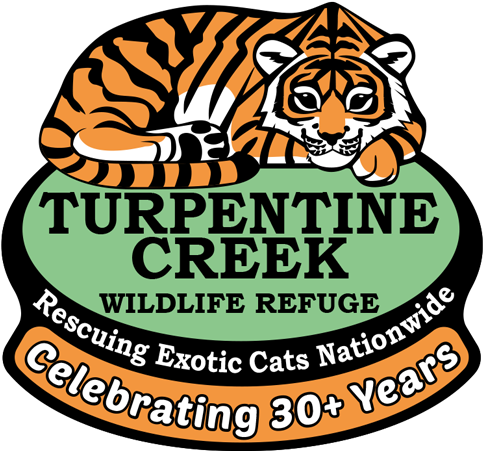
Zulu Safari Lodging Adults Only
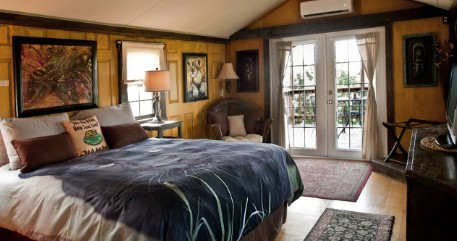
Kilimanjaro Suite at the Zulu Lodge
Pets Prohibited
Starting at $200 per night | Ages 18+ only | 2 guests | No pets
- The Kilimanjaro suite offers a luscious, exotic palette of color throughout. Delicately carved African masks adorn the cabin as well as the art of Lisa and D. Arthur Wilson. The large, rustic entertainment unit is home to familiar games and books as well as Scott Smith’s charming photos of some of the residents at TCWR! The private deck of this suite boasts views of the sprawling valley and beautiful sunrises.
- This suite sleeps 2 guests above the age of 18-years old.
- The Refuge is a nonprofit organization and the cost of your stay goes toward the care of our animal residents.
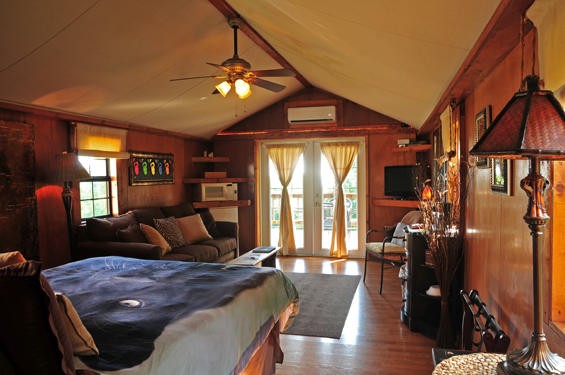
Congo Suite at the Zulu Lodge
- The Congo Suite offers a beautiful reminder of Africa. The color scheme is tan with pops of color in the art that D. Wilson and Lisa Wilson placed throughout. With the rolling hills of Ozarks surrounding the Congo, you will get the full “Africa in the Ozarks” experience! The private deck of this suite boasts views of the sprawling valley and beautiful sunrises.
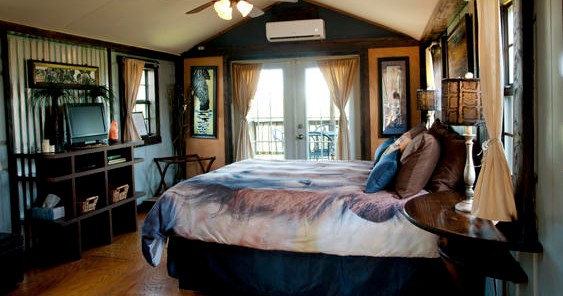
Okavango Suite at the Zulu Lodge
Starting at $200 per night | Ages 18+ | 2 guests | Ramp-Accessible (not ADA)
- The Okavango suite is artistically styled with a beautiful blue hue and aluminum colors providing you with a feeling of relaxation and rejuvenation. Meerkats are waiting to greet you in D. Arthur Wilson’s “No Meer Family” giclee print. The spacious bathroom offers a shower large enough for two people. A shower seat is available if needed. Also available if needed are the toilet safety frame and rails in the shower. Both decks are charming with the back deck boasting lovely views of the sprawling valley and beautiful sunsets.
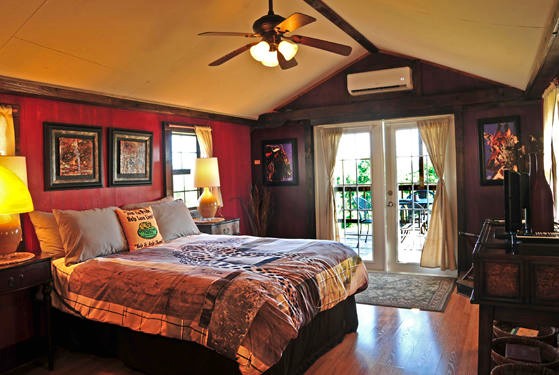
Serengeti Suite at the Zulu Lodge
Starting at $200 per night | Ages 18+ | 2 guests | Sunset motifs
- The Serengeti suite is designed in a purple and red combination delivering the colors of our breathtaking Ozark sunsets. This suite’s artwork by D. Arthur and Lisa Wilson might have you believe you are actually in Africa! The presentation of Lisa’s Mixed Media original art, Passion 2 and Passion 4, hangs over the Queen size bed. The Serengeti suite has many giclee prints like along with a beautiful male lion print over the love seat. Wildebeest, zebras, and giraffes fill this room along with fantastic photographs taken by Scott Smith, our TCWR resident photographer. The private deck of this suite boasts both views of the sprawling valley and beautiful sunrises.
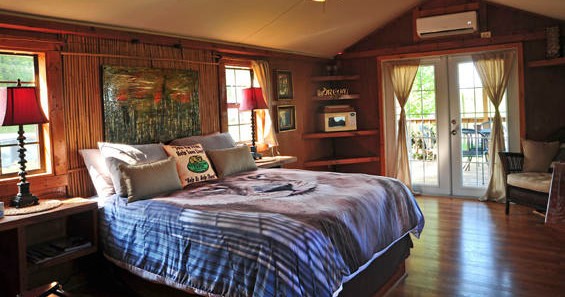
Kalahari Suite at the Zulu Lodge
- The Kalahari suite is a cozy escape with an exotic theme of bamboo and jewel tones throughout. The artistic bamboo headboard above the Queen bed is complemented by original abstract art from Lisa Wilson and D. Arthur Wilson’s Wild Expressionism limited editions. As you relax on either the front or back decks, the gentle caroling of the big cats is music to your ears!
- This suite sleeps 2 guests above the age of 18 and is open from March until November.
Cheetahs and dogs have been pals for decades at the Cincinnati Zoo. We learned how it works

Rozi, a 2-year-old cheetah, came to the Cincinnati Zoo & Botanical Garden from the Wildlife Safari in Oregon in 2022 as a single cub, rejected by her mother. But she wasn't alone for long. Through the zoo's Cat Ambassador Program, Rozi met Daisy, an adopted mixed-breed puppy, and made a once-in-a-lifetime friend.
Cheetahs are, by nature, solitary creatures when they reach maturity around age 2, Andie Haugen, senior trainer at the zoo's Cat Ambassador Program, said. However, they normally grow up with siblings, with whom they play, chase and develop important skills. Since 1981, the Cincinnati Zoo has paired single cheetah cubs with puppies to replicate this bond.
"They're like surrogate siblings, essentially, to the cheetah," Haugen said.
The Enquirer met Remus and Moose, the Cat Ambassador Program's two other dogs, watched Daisy and Rozi play and learned more about the history of this unlikely, but important, friendship.
How doggy-cheetah friendships began
At the Cincinnati Zoo, it all started with Cathryn Hilker , a Mason, Ohio, native and founder of the zoo's Cat Ambassador Program. She has championed the species for decades.
Hilker raised ambassador cats in her home starting in the 80s. Angel, the zoo's first cheetah ambassador, became fast friends with Hilker's Great Dane, Dominic , which helped Hilker realize dogs could serve as companions for solo cheetah cubs growing up without their mothers.
Cheetahs reach maturity around age 2 or 3, which is when, in the wild, they would leave their families and set out on their own. Zoo cheetahs also get more independent around this age and spend less time with their companion dogs.
"It's kind of like when you share a room with your sibling growing up, you reach a certain point where you're like, 'I want my own space,'" Haugen said.
The furry friends are still able to hang out with each other when they want to and have "sleepovers" on occasion, Haugen said. When a dog fully retires from the Cat Ambassador Program, a zoo staff member adopts them. The program is currently at capacity, and wouldn't take on another dog without retiring one, Haugen said.
How are dog companions picked?
When scouting out a cheetah's new best friend, zoo keepers look for playful puppies of a similar age, and have adopted dogs from the Animal Rescue Fund shelter in Amelia, Ohio. The dog's breed isn't that important; it's all about personality. However, Labrador mixes have historically made a good match, Haugen said, because of the breed's good nature.
Cheetahs and domesticated dogs would likely never meet in the wild. But raised alongside each other at zoos, 24 hours a day when they're little, they form a bond and learn to communicate.
Cheetahs don't roar – they purr and meow. When The Enquirer team watched Rozi and Daisy play in the zoo's cheetah encounter, a growl from Rozi clearly meant: "This is my football." Cheetah cubs might also make a chirping sound to let keepers know they miss their companion dog, Haugen said.
"Cheetah siblings, that's what they'd be doing – they'd be running around, biting each other and playing," she explained. "That's what the dog serves as, that role for them. And they kind of each have their own relationship."
Those relationships have been well-documented. Remus, whose cheetah friend is Kris, was even featured on the 2020 Disney+ show, "It's A Dog's Life," which explored the many jobs of canines and was narrated by Bill Farmer, the voice of Goofy.
How do big cats become ambassadors?
Cheetahs in the Cat Ambassador Program were not able to be raised by their mothers, and are therefore raised by humans in zoos. In zoos and in the wild, a mother cheetah will often abandon a single-cub litter because it's less likely to survive into adulthood.
Single cubs like Rozi are hand-raised by zoo keepers, making them more comfortable with humans and prime candidates for ambassadorships.
The Cat Ambassador Program aims to educate people about big cats and inspire them to help save these creatures. Cat ambassadors run in the zoo's cheetah encounter, appear in classrooms and are trained to travel and walk on a leash.
As an ambassador, Rozi will live at the Cincinnati Zoo her whole life. She also likely won't breed, because the genetic diversity of ambassador cheetahs is already well-represented.
The Cincinnati Zoo is part of a nationwide cheetah breeding coalition, led by the Conservation Centers for Species Survival . According to the organization, cheetah births in North America have increased by 85% because of the program, which facilitates cheetah breeding across a network of zoos. As a result, the group of 350 cheetahs in the coalition has a greater genetic diversity than wild populations in Africa, Haugen said.
"It's kind of a safeguard for the cheetah population as a whole, because we're safeguarding these good genetics here in zoos in case things keep going poorly in Africa," she added.
How else do dogs help protect vulnerable species?
Poaching, human-animal conflict and habitat loss have made cheetahs a vulnerable species, according to the International Union for Conservation of Nature.
The Cincinnati Zoo provides guard dogs to farmers in Namibia, home to the world's largest population of cheetahs. Dogs keep cheetahs away from livestock, which means they aren't killed by farmers.
The Cheetah Conservation Fund's trained scat detection dogs help researchers learn the genetic profile of cheetahs in the wild. Dogs' sense of smell is also used to stop smugglers because they can sniff out ivory , the white material that comes from the tusks of elephants and other animals.
How to see Rozi at the Cincinnati Zoo
Watch Rozi and other cheetahs run in the Kroger Cheetah Encounter , resuming for the summer season May 25. Cheetah encounters are free with zoo admission, and happen at 10:30 a.m. and noon Friday through Tuesday.
This story was part of a series in which The Enquirer meets and learns about Cincinnati Zoo animals. Read our previous article in which we met Fiona the hippo and her family here .

IMAGES
COMMENTS
Wild Dog Safaris - Namibia - Have truck will travel. Oct 2016. Having travelled across most of Namibia with Wild Dog Safaris, I cannot praise enough the patience and care taken by their guides and cooks. I also was very happy with their booking process and the assistant provided by their office staff. The accommodation at Windhoek selected by ...
Pick up & drop off from accommodation in Windhoek. Safaris exclude: Sleeping bag (can be hired) Alcoholic beverages. Soft drinks & bottled water. Personal travel insurance. Experience the beauty of Namibia with Wild Dog Safaris' adventure tours. Relax and explore with trips running since 1997. Book your adventure today!
12 days • 4 locations. MAUN AIRPORT TO VICTORIA FALLS AIRPORT. This wonderfully varied adventure combines Botswana's Okavango Delta and a live-aboard houseboat safari on the Chobe River, with big game in Zimbabwe's dry Hwange National Park and the stupendous Victoria Falls. US$9,240 - US$17,150 per person.
Average Customer Rating. 4.9. All corporate and/or tour info is provided by Wild Dog Safaris, not SafariBookings. The tours offered by Wild Dog Safaris are subject to their terms & conditions. Average rating: 4.9/5 stars, based on 64 reviews. Wild Dog Safaris has been in operation since 1997 and specializes in camping and accommodated safaris at.
I went on the 3 day camping safari to Etosha National Park from Windhoek in December 2017. The trip was amazing and I definitely recommend Wild Dog Safaris to anyone visiting Namibia! The service was great, staff picked me up from my lodging in Windhoek and brought me to meet my excursion group at the Windhoek offices.
Thank you for choosing Wild Dog Safaris for you travels to Namibia , and for taking the time to write a review! We are so glad to hear that you enjoyed your 14 day Namibian Experience Camping Trip with us. Our aim is to provide a truly unique experience, and we are thrilled that we were able to offer you great service and good value for money. ...
Wild Dog Safaris Namibia, Windhoek: See 548 reviews, articles, and 440 photos of Wild Dog Safaris Namibia, one of 250 Windhoek attractions listed on Tripadvisor.
Wild Dog Safaris Namibia, Windhoek: See 548 reviews, articles, and 440 photos of Wild Dog Safaris Namibia, one of 242 Windhoek attractions listed on Tripadvisor.
Jun 2021. I booked a 7 days tour in Namibia with Wild Dog Safaris for April 2020, after the covid-19, I asked for a refund but they gave excuses to make the reimbursement. After that I realized that the company was in liquidation process, so I contacted the lawyer in Namibia who was the responsible of the legal process (ERASMUS & ASSOCIATES).
Overall experience with Wild Dog Safaris Namibia: 9/10. Pure joy at the end of my first day on safari with Wild Dog. In sum, I could not be happier with my overall Wild Dog Safaris experience. The guides were great, the food was good, the campsites were amazing, and I got to do every single activity I'd wanted to — and then some.
Things to do near Wild Dog Safaris Namibia. Pack Safari Bluecrane Safaris Namibia Chameleon Safaris Adventure Camping Hire Scenic Air Wild Wind Safaris Safari Car Rental Namibia Craft Centre Quest Tours and Safaris Desert Air Lark Journeys Mwiya Tours and Transfers Wild Cherry Adventures Maerua Mall Barrel & Grove, ...
Wild Dog & Crazy Kudu Safaris 22 day Namibia, Okavango Delta & Victoria Falls Assisted Camping Safari Emergency phone number ++ 264 61 257 642 Guaranteed departures on Fridays It is strongly recommended that you purchase comprehensive personal travel insurance before you embark on your safari. Travel insurance is for your own protection and we ...
We first choose Wild Dog Safari because the organisation was serious. We had very short time to organize a trip in Namibia and Wild Dog Safari helped us booking our tour. We had a wonderful 7 days. The guide and the camp help were awesome and installed a nice and relaxed atmosphere. We spent three days in Etosha and three days in the desert.
WINDHOEK AIRPORT TO WINDHOEK AIRPORT. Explore Namibia's remotest wildernesses while staying at some of the most exclusive luxury camps in the country. This epic fly-in safari will deliver otherworldly landscapes, fascinating wildlife and genuine cultural experiences. US$10,300 - US$15,700 per person. Desert Rhino Camp.
We are due back into the city around 16:00 and you will be dropped off at your accommodation on our return. Tonight the accommodation is not included in the price of the safari. Wild Dog Safaris 10 Day North & South Combination Safari Assisted Camping Safari. Guaranteed departures every Thursday of the year, all year.
11. Xigera Safari Lodge, Okavango Delta. The Moremi Game Reserve is one of Africa's most beautiful conservation areas: a stunning montage of lily-covered wetlands, sparkling floodplains, open grassland and dappled forests. It's home to some of Botswana's best predator sightings and the celebrated Xigera Safari Lodge.
Starting at $200 per night | Ages 18+ only | 2 guests | No pets. The Kilimanjaro suite offers a luscious, exotic palette of color throughout. Delicately carved African masks adorn the cabin as well as the art of Lisa and D. Arthur Wilson. The large, rustic entertainment unit is home to familiar games and books as well as Scott Smith's ...
Rozi, a 2-year-old cheetah, came to the Cincinnati Zoo & Botanical Garden from the Wildlife Safari in Oregon in 2022 as a single cub, rejected by her mother. But she wasn't alone for long. Through ...
Safari Tour. Join one of our friendly keepers on an adventure around the large animal habitats. Riding through the habitats in a van, guests will have the opportunity to view keeper training and feeding demos. Hours of Operation. $162.50 per adult, $84.50 for ages 3-12. 2 and under are free of charge. price includes taxes & gratuity.
I booked a 7 days tour in Namibia with Wild Dog Safaris for April 2020, after the covid-19, I asked for a refund but they gave excuses to make the reimbursement. After that I realized that the company was in liquidation process, so I contacted the lawyer in Namibia who was the responsible of the legal process (ERASMUS & ASSOCIATES).
september 2015, Moscow, Russia.The full version is here https://youtu.be/Mz1r7IihWQk
Skip to main content. Discover. Trips